Contemporary Issues in Health and Social Care: A Study of Stroke
VerifiedAdded on 2024/06/07
|20
|4902
|51
AI Summary
This report explores contemporary issues in health and social care, focusing on the impact of stroke. It examines how information about stroke reaches the public domain, analyzes different perspectives on the issue, and evaluates the impact of contemporary thinking on health and social care provisions. The report highlights the importance of public awareness campaigns, advancements in stroke treatment, and the need for innovative approaches to health and social care delivery.
Contribute Materials
Your contribution can guide someone’s learning journey. Share your
documents today.
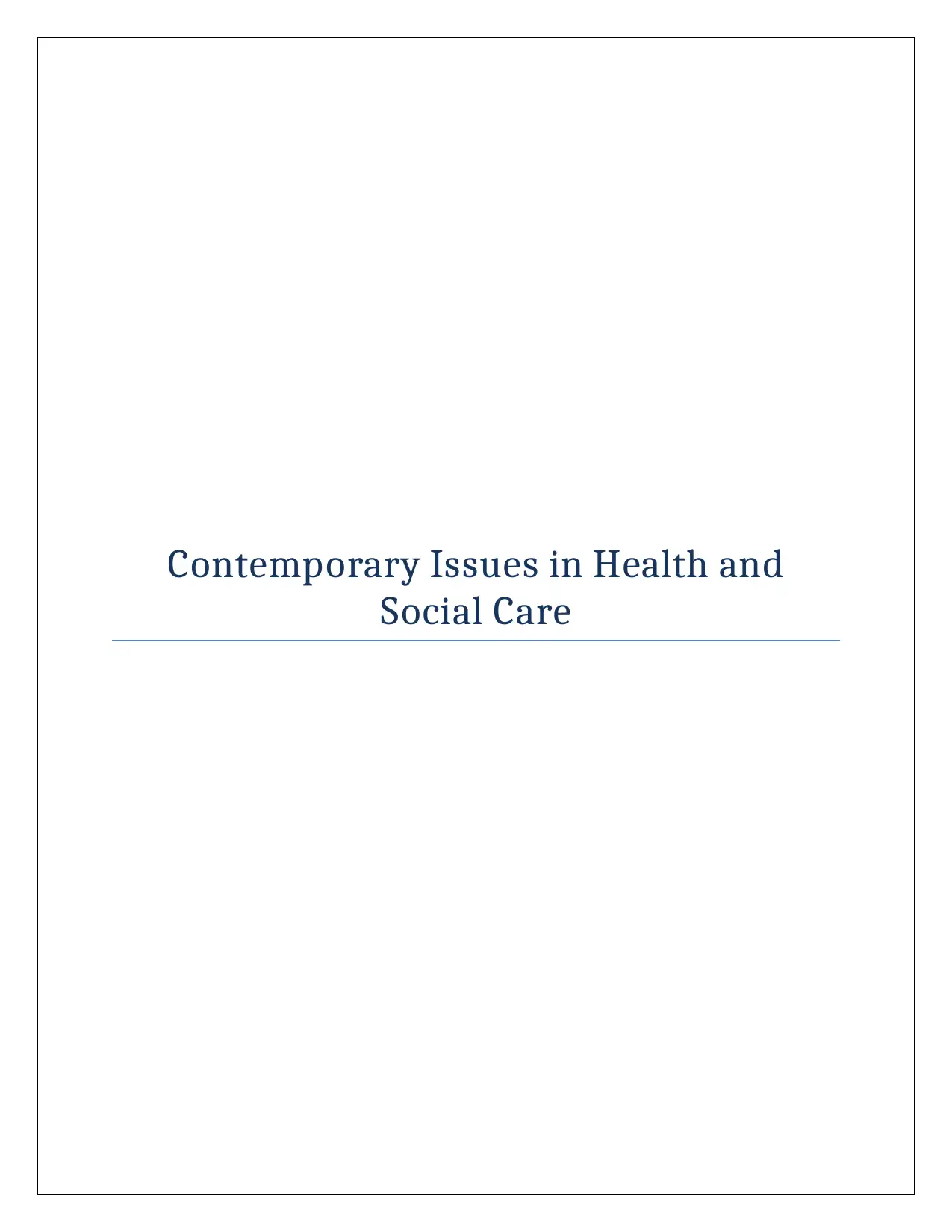
Contemporary Issues in Health and
Social Care
Social Care
Secure Best Marks with AI Grader
Need help grading? Try our AI Grader for instant feedback on your assignments.
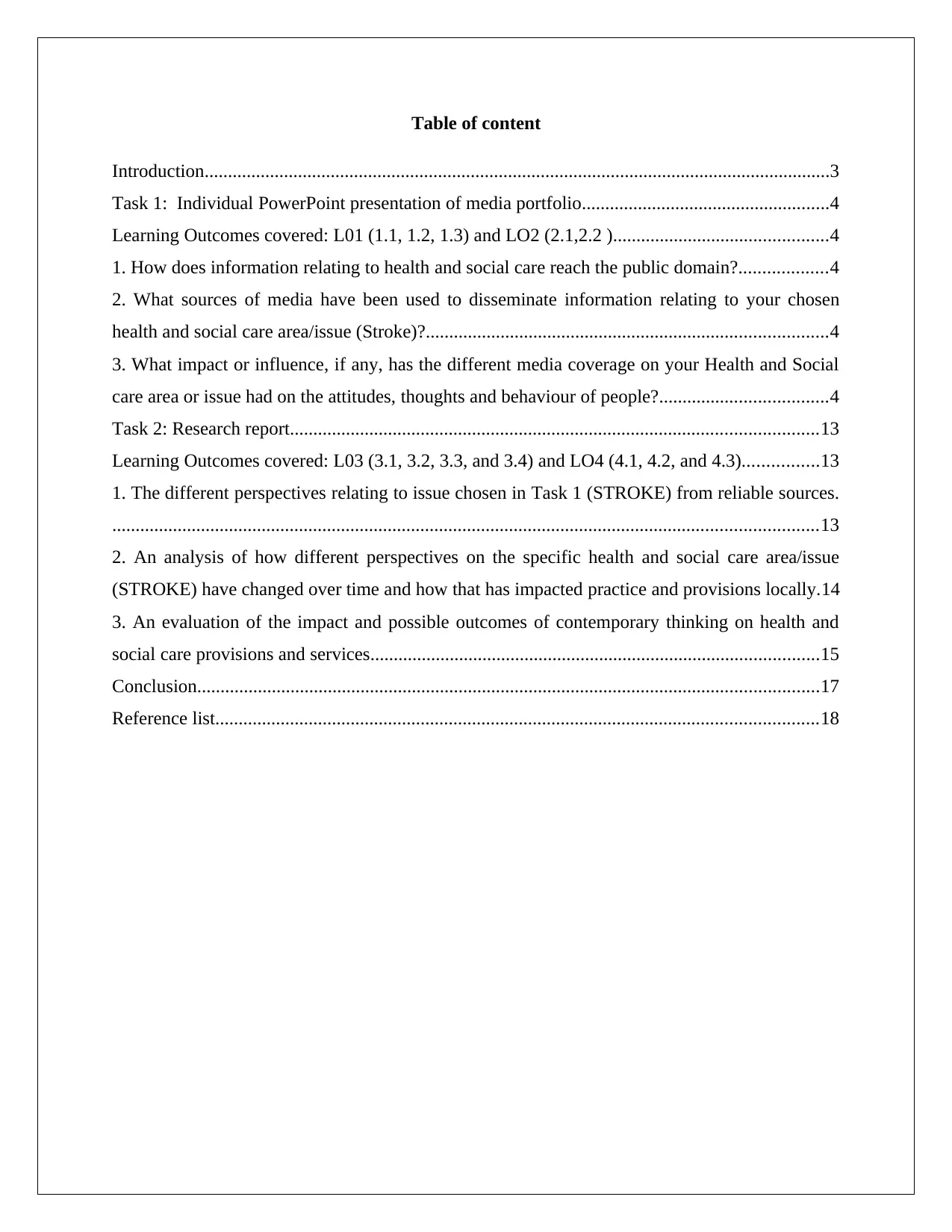
Table of content
Introduction......................................................................................................................................3
Task 1: Individual PowerPoint presentation of media portfolio.....................................................4
Learning Outcomes covered: L01 (1.1, 1.2, 1.3) and LO2 (2.1,2.2 )..............................................4
1. How does information relating to health and social care reach the public domain?...................4
2. What sources of media have been used to disseminate information relating to your chosen
health and social care area/issue (Stroke)?......................................................................................4
3. What impact or influence, if any, has the different media coverage on your Health and Social
care area or issue had on the attitudes, thoughts and behaviour of people?....................................4
Task 2: Research report.................................................................................................................13
Learning Outcomes covered: L03 (3.1, 3.2, 3.3, and 3.4) and LO4 (4.1, 4.2, and 4.3)................13
1. The different perspectives relating to issue chosen in Task 1 (STROKE) from reliable sources.
.......................................................................................................................................................13
2. An analysis of how different perspectives on the specific health and social care area/issue
(STROKE) have changed over time and how that has impacted practice and provisions locally.14
3. An evaluation of the impact and possible outcomes of contemporary thinking on health and
social care provisions and services................................................................................................15
Conclusion.....................................................................................................................................17
Reference list.................................................................................................................................18
Introduction......................................................................................................................................3
Task 1: Individual PowerPoint presentation of media portfolio.....................................................4
Learning Outcomes covered: L01 (1.1, 1.2, 1.3) and LO2 (2.1,2.2 )..............................................4
1. How does information relating to health and social care reach the public domain?...................4
2. What sources of media have been used to disseminate information relating to your chosen
health and social care area/issue (Stroke)?......................................................................................4
3. What impact or influence, if any, has the different media coverage on your Health and Social
care area or issue had on the attitudes, thoughts and behaviour of people?....................................4
Task 2: Research report.................................................................................................................13
Learning Outcomes covered: L03 (3.1, 3.2, 3.3, and 3.4) and LO4 (4.1, 4.2, and 4.3)................13
1. The different perspectives relating to issue chosen in Task 1 (STROKE) from reliable sources.
.......................................................................................................................................................13
2. An analysis of how different perspectives on the specific health and social care area/issue
(STROKE) have changed over time and how that has impacted practice and provisions locally.14
3. An evaluation of the impact and possible outcomes of contemporary thinking on health and
social care provisions and services................................................................................................15
Conclusion.....................................................................................................................................17
Reference list.................................................................................................................................18
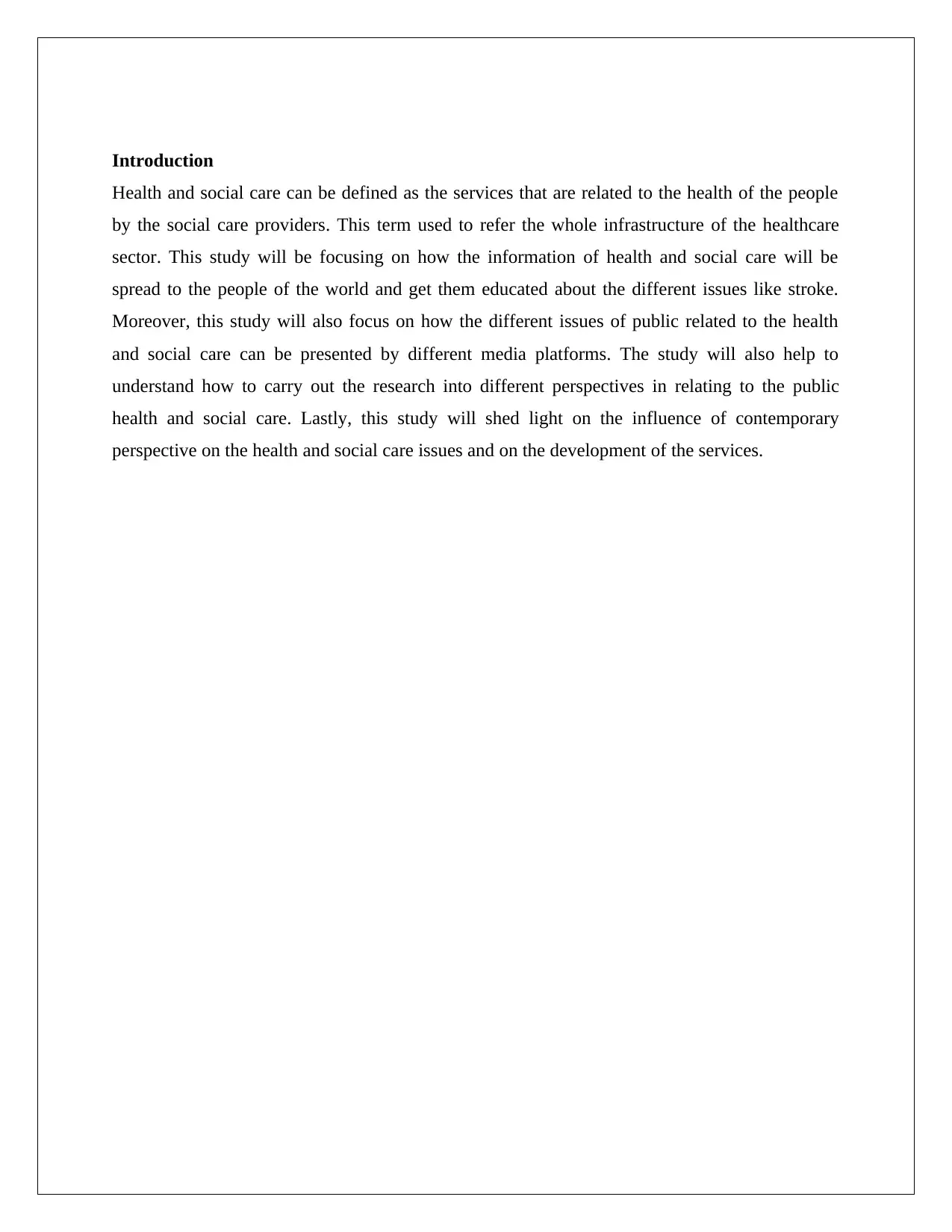
Introduction
Health and social care can be defined as the services that are related to the health of the people
by the social care providers. This term used to refer the whole infrastructure of the healthcare
sector. This study will be focusing on how the information of health and social care will be
spread to the people of the world and get them educated about the different issues like stroke.
Moreover, this study will also focus on how the different issues of public related to the health
and social care can be presented by different media platforms. The study will also help to
understand how to carry out the research into different perspectives in relating to the public
health and social care. Lastly, this study will shed light on the influence of contemporary
perspective on the health and social care issues and on the development of the services.
Health and social care can be defined as the services that are related to the health of the people
by the social care providers. This term used to refer the whole infrastructure of the healthcare
sector. This study will be focusing on how the information of health and social care will be
spread to the people of the world and get them educated about the different issues like stroke.
Moreover, this study will also focus on how the different issues of public related to the health
and social care can be presented by different media platforms. The study will also help to
understand how to carry out the research into different perspectives in relating to the public
health and social care. Lastly, this study will shed light on the influence of contemporary
perspective on the health and social care issues and on the development of the services.
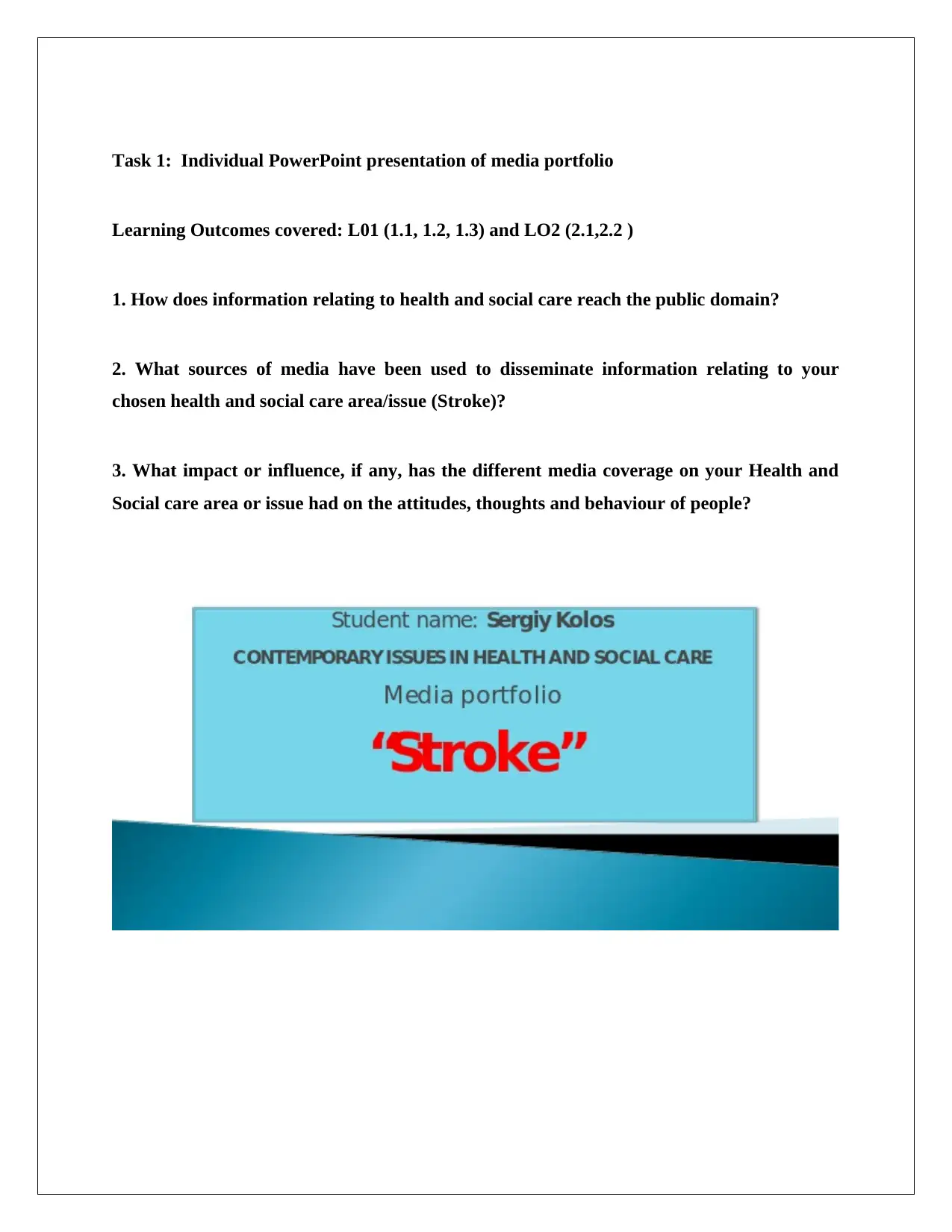
Task 1: Individual PowerPoint presentation of media portfolio
Learning Outcomes covered: L01 (1.1, 1.2, 1.3) and LO2 (2.1,2.2 )
1. How does information relating to health and social care reach the public domain?
2. What sources of media have been used to disseminate information relating to your
chosen health and social care area/issue (Stroke)?
3. What impact or influence, if any, has the different media coverage on your Health and
Social care area or issue had on the attitudes, thoughts and behaviour of people?
Learning Outcomes covered: L01 (1.1, 1.2, 1.3) and LO2 (2.1,2.2 )
1. How does information relating to health and social care reach the public domain?
2. What sources of media have been used to disseminate information relating to your
chosen health and social care area/issue (Stroke)?
3. What impact or influence, if any, has the different media coverage on your Health and
Social care area or issue had on the attitudes, thoughts and behaviour of people?
Secure Best Marks with AI Grader
Need help grading? Try our AI Grader for instant feedback on your assignments.
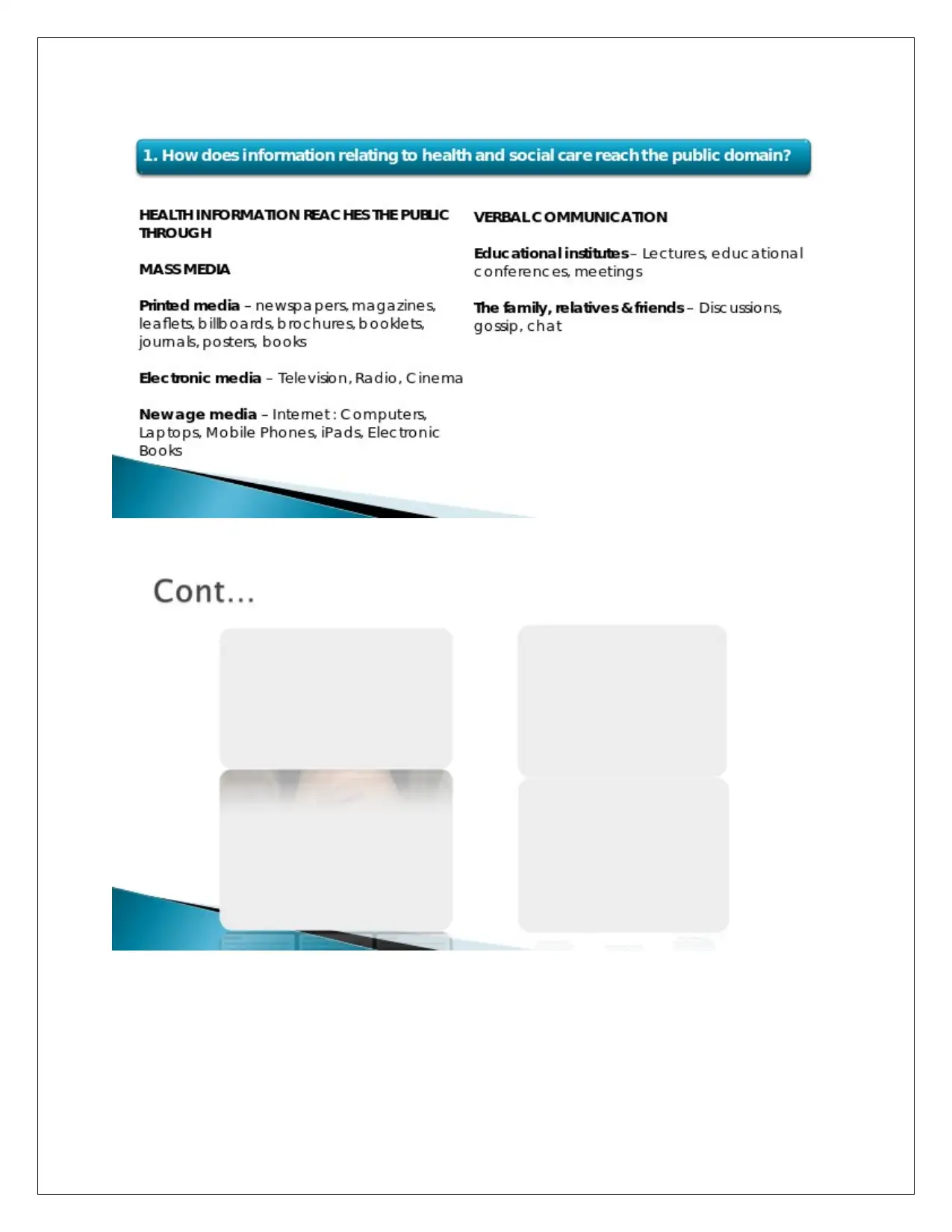
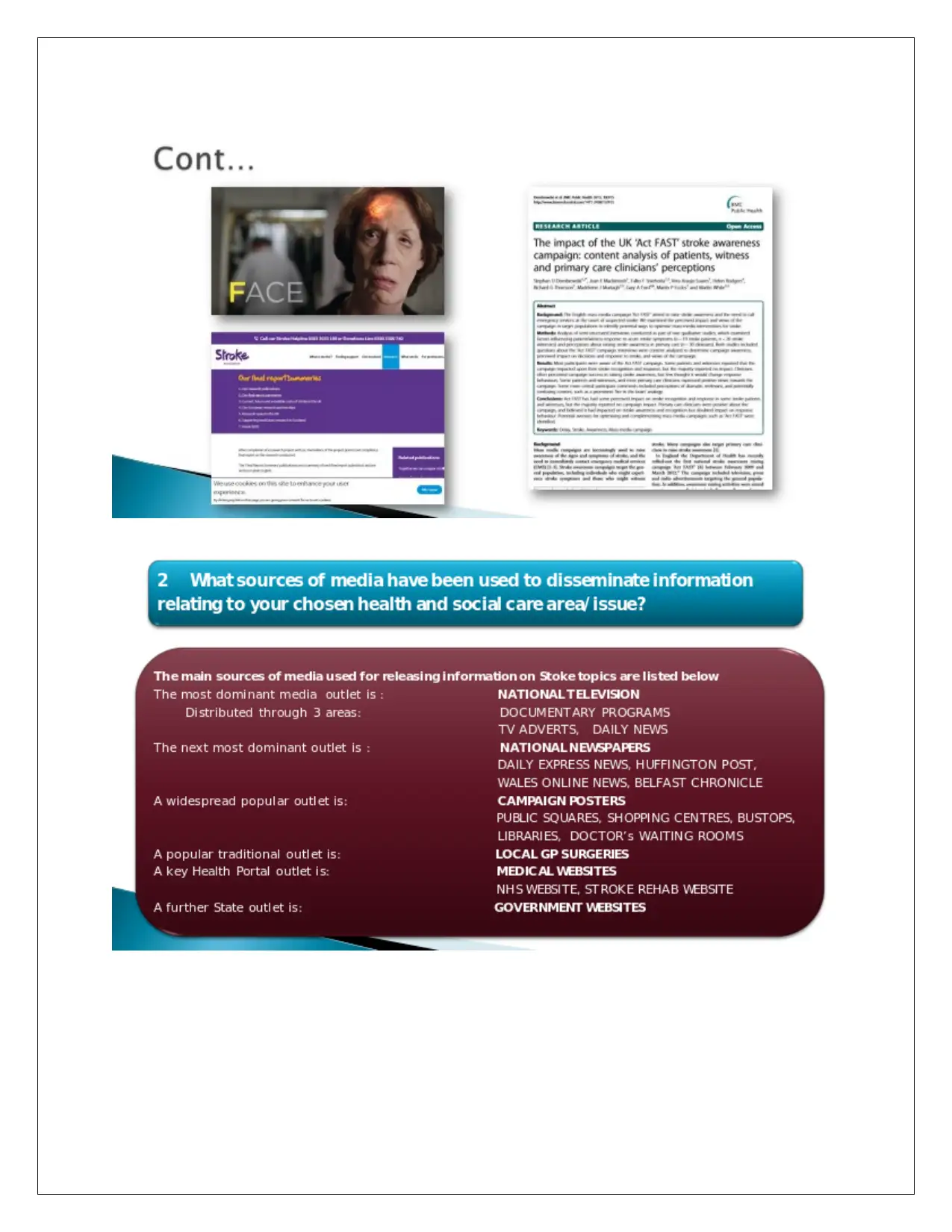
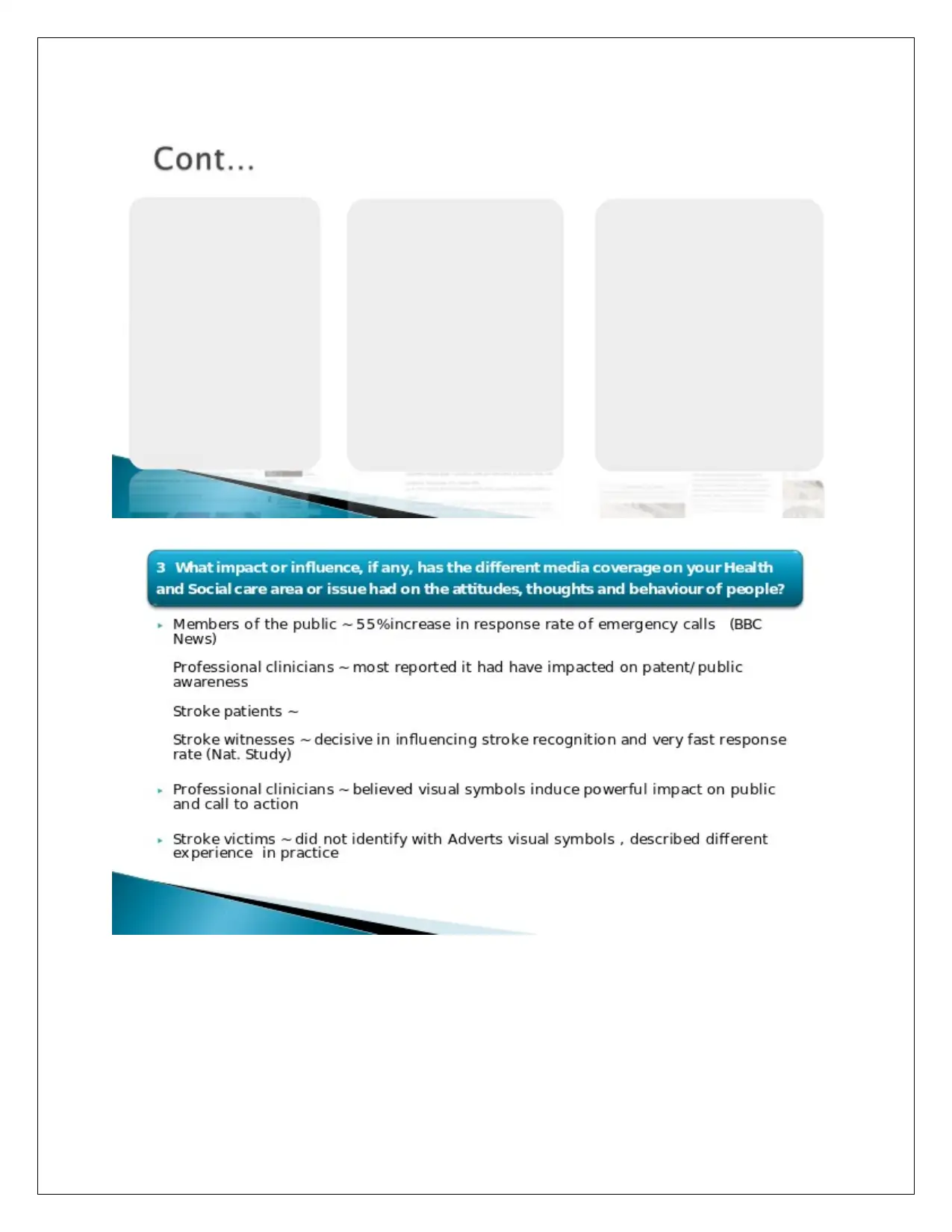
Paraphrase This Document
Need a fresh take? Get an instant paraphrase of this document with our AI Paraphraser
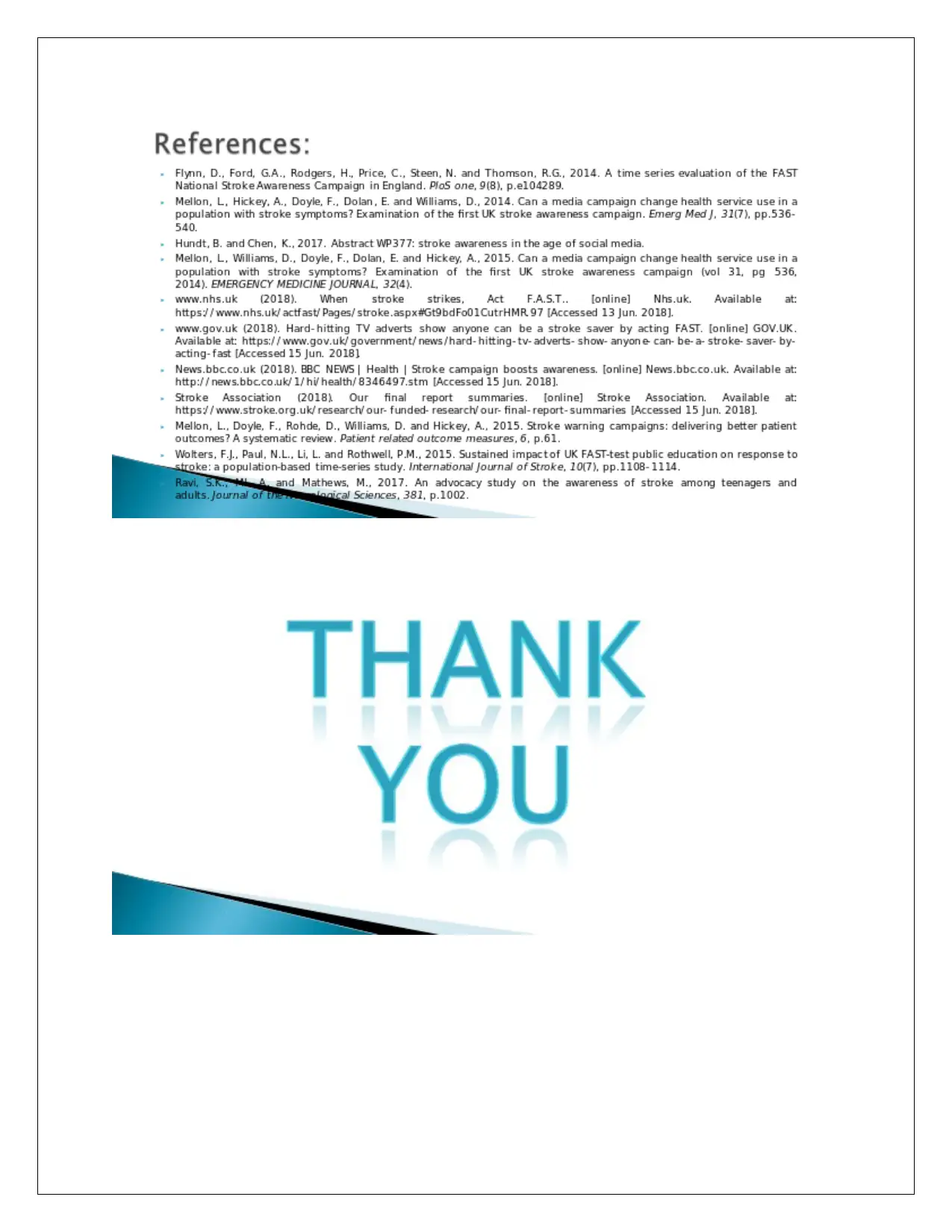
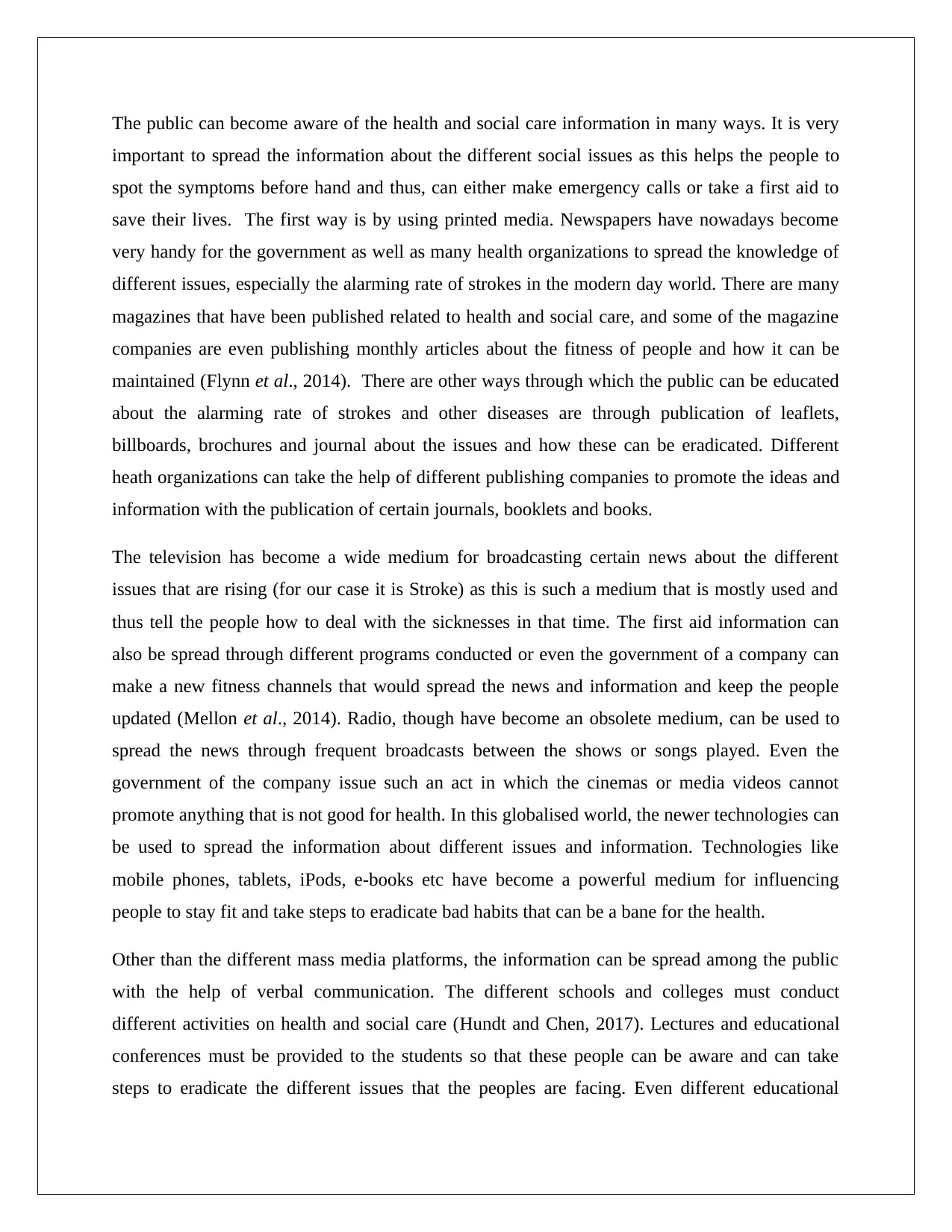
The public can become aware of the health and social care information in many ways. It is very
important to spread the information about the different social issues as this helps the people to
spot the symptoms before hand and thus, can either make emergency calls or take a first aid to
save their lives. The first way is by using printed media. Newspapers have nowadays become
very handy for the government as well as many health organizations to spread the knowledge of
different issues, especially the alarming rate of strokes in the modern day world. There are many
magazines that have been published related to health and social care, and some of the magazine
companies are even publishing monthly articles about the fitness of people and how it can be
maintained (Flynn et al., 2014). There are other ways through which the public can be educated
about the alarming rate of strokes and other diseases are through publication of leaflets,
billboards, brochures and journal about the issues and how these can be eradicated. Different
heath organizations can take the help of different publishing companies to promote the ideas and
information with the publication of certain journals, booklets and books.
The television has become a wide medium for broadcasting certain news about the different
issues that are rising (for our case it is Stroke) as this is such a medium that is mostly used and
thus tell the people how to deal with the sicknesses in that time. The first aid information can
also be spread through different programs conducted or even the government of a company can
make a new fitness channels that would spread the news and information and keep the people
updated (Mellon et al., 2014). Radio, though have become an obsolete medium, can be used to
spread the news through frequent broadcasts between the shows or songs played. Even the
government of the company issue such an act in which the cinemas or media videos cannot
promote anything that is not good for health. In this globalised world, the newer technologies can
be used to spread the information about different issues and information. Technologies like
mobile phones, tablets, iPods, e-books etc have become a powerful medium for influencing
people to stay fit and take steps to eradicate bad habits that can be a bane for the health.
Other than the different mass media platforms, the information can be spread among the public
with the help of verbal communication. The different schools and colleges must conduct
different activities on health and social care (Hundt and Chen, 2017). Lectures and educational
conferences must be provided to the students so that these people can be aware and can take
steps to eradicate the different issues that the peoples are facing. Even different educational
important to spread the information about the different social issues as this helps the people to
spot the symptoms before hand and thus, can either make emergency calls or take a first aid to
save their lives. The first way is by using printed media. Newspapers have nowadays become
very handy for the government as well as many health organizations to spread the knowledge of
different issues, especially the alarming rate of strokes in the modern day world. There are many
magazines that have been published related to health and social care, and some of the magazine
companies are even publishing monthly articles about the fitness of people and how it can be
maintained (Flynn et al., 2014). There are other ways through which the public can be educated
about the alarming rate of strokes and other diseases are through publication of leaflets,
billboards, brochures and journal about the issues and how these can be eradicated. Different
heath organizations can take the help of different publishing companies to promote the ideas and
information with the publication of certain journals, booklets and books.
The television has become a wide medium for broadcasting certain news about the different
issues that are rising (for our case it is Stroke) as this is such a medium that is mostly used and
thus tell the people how to deal with the sicknesses in that time. The first aid information can
also be spread through different programs conducted or even the government of a company can
make a new fitness channels that would spread the news and information and keep the people
updated (Mellon et al., 2014). Radio, though have become an obsolete medium, can be used to
spread the news through frequent broadcasts between the shows or songs played. Even the
government of the company issue such an act in which the cinemas or media videos cannot
promote anything that is not good for health. In this globalised world, the newer technologies can
be used to spread the information about different issues and information. Technologies like
mobile phones, tablets, iPods, e-books etc have become a powerful medium for influencing
people to stay fit and take steps to eradicate bad habits that can be a bane for the health.
Other than the different mass media platforms, the information can be spread among the public
with the help of verbal communication. The different schools and colleges must conduct
different activities on health and social care (Hundt and Chen, 2017). Lectures and educational
conferences must be provided to the students so that these people can be aware and can take
steps to eradicate the different issues that the peoples are facing. Even different educational
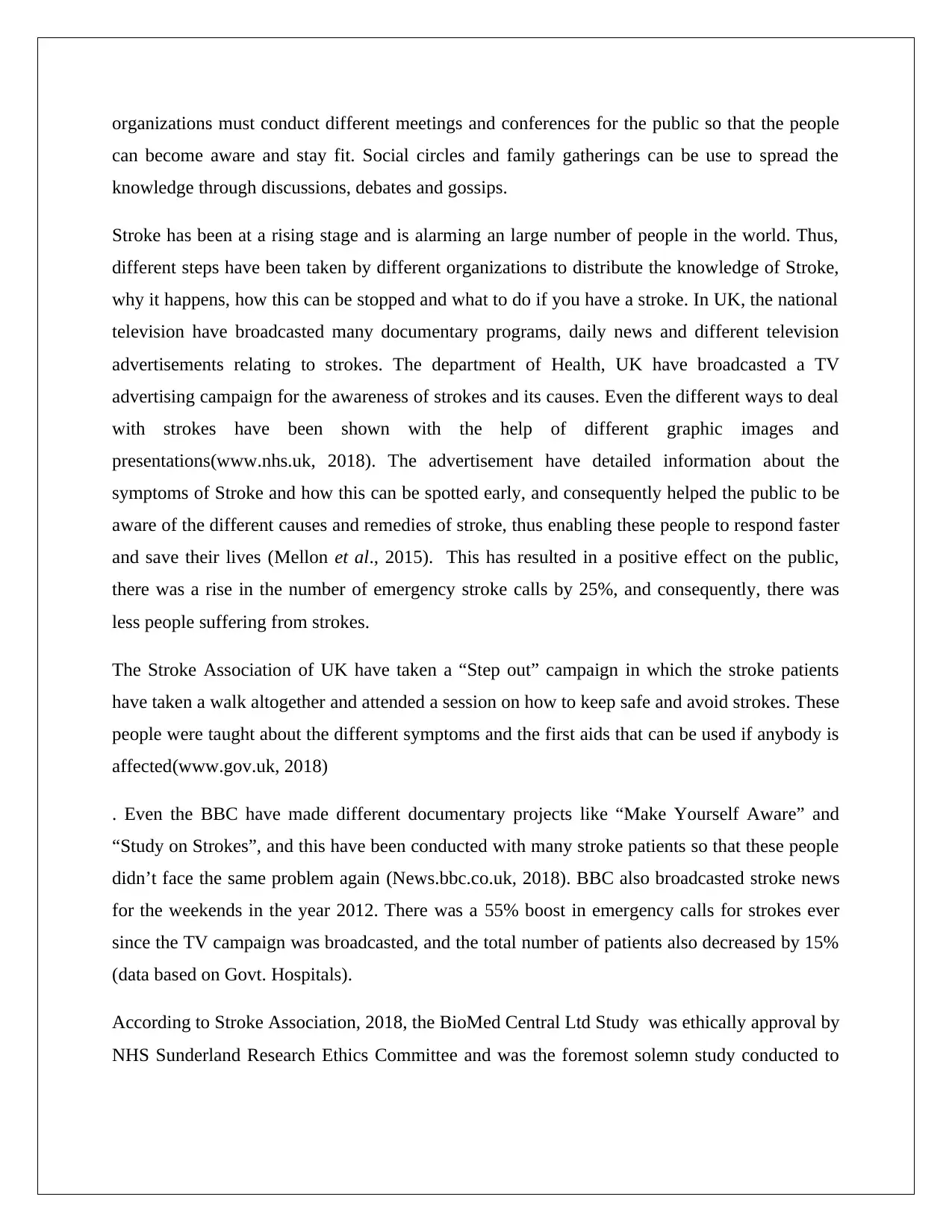
organizations must conduct different meetings and conferences for the public so that the people
can become aware and stay fit. Social circles and family gatherings can be use to spread the
knowledge through discussions, debates and gossips.
Stroke has been at a rising stage and is alarming an large number of people in the world. Thus,
different steps have been taken by different organizations to distribute the knowledge of Stroke,
why it happens, how this can be stopped and what to do if you have a stroke. In UK, the national
television have broadcasted many documentary programs, daily news and different television
advertisements relating to strokes. The department of Health, UK have broadcasted a TV
advertising campaign for the awareness of strokes and its causes. Even the different ways to deal
with strokes have been shown with the help of different graphic images and
presentations(www.nhs.uk, 2018). The advertisement have detailed information about the
symptoms of Stroke and how this can be spotted early, and consequently helped the public to be
aware of the different causes and remedies of stroke, thus enabling these people to respond faster
and save their lives (Mellon et al., 2015). This has resulted in a positive effect on the public,
there was a rise in the number of emergency stroke calls by 25%, and consequently, there was
less people suffering from strokes.
The Stroke Association of UK have taken a “Step out” campaign in which the stroke patients
have taken a walk altogether and attended a session on how to keep safe and avoid strokes. These
people were taught about the different symptoms and the first aids that can be used if anybody is
affected(www.gov.uk, 2018)
. Even the BBC have made different documentary projects like “Make Yourself Aware” and
“Study on Strokes”, and this have been conducted with many stroke patients so that these people
didn’t face the same problem again (News.bbc.co.uk, 2018). BBC also broadcasted stroke news
for the weekends in the year 2012. There was a 55% boost in emergency calls for strokes ever
since the TV campaign was broadcasted, and the total number of patients also decreased by 15%
(data based on Govt. Hospitals).
According to Stroke Association, 2018, the BioMed Central Ltd Study was ethically approval by
NHS Sunderland Research Ethics Committee and was the foremost solemn study conducted to
can become aware and stay fit. Social circles and family gatherings can be use to spread the
knowledge through discussions, debates and gossips.
Stroke has been at a rising stage and is alarming an large number of people in the world. Thus,
different steps have been taken by different organizations to distribute the knowledge of Stroke,
why it happens, how this can be stopped and what to do if you have a stroke. In UK, the national
television have broadcasted many documentary programs, daily news and different television
advertisements relating to strokes. The department of Health, UK have broadcasted a TV
advertising campaign for the awareness of strokes and its causes. Even the different ways to deal
with strokes have been shown with the help of different graphic images and
presentations(www.nhs.uk, 2018). The advertisement have detailed information about the
symptoms of Stroke and how this can be spotted early, and consequently helped the public to be
aware of the different causes and remedies of stroke, thus enabling these people to respond faster
and save their lives (Mellon et al., 2015). This has resulted in a positive effect on the public,
there was a rise in the number of emergency stroke calls by 25%, and consequently, there was
less people suffering from strokes.
The Stroke Association of UK have taken a “Step out” campaign in which the stroke patients
have taken a walk altogether and attended a session on how to keep safe and avoid strokes. These
people were taught about the different symptoms and the first aids that can be used if anybody is
affected(www.gov.uk, 2018)
. Even the BBC have made different documentary projects like “Make Yourself Aware” and
“Study on Strokes”, and this have been conducted with many stroke patients so that these people
didn’t face the same problem again (News.bbc.co.uk, 2018). BBC also broadcasted stroke news
for the weekends in the year 2012. There was a 55% boost in emergency calls for strokes ever
since the TV campaign was broadcasted, and the total number of patients also decreased by 15%
(data based on Govt. Hospitals).
According to Stroke Association, 2018, the BioMed Central Ltd Study was ethically approval by
NHS Sunderland Research Ethics Committee and was the foremost solemn study conducted to
Secure Best Marks with AI Grader
Need help grading? Try our AI Grader for instant feedback on your assignments.
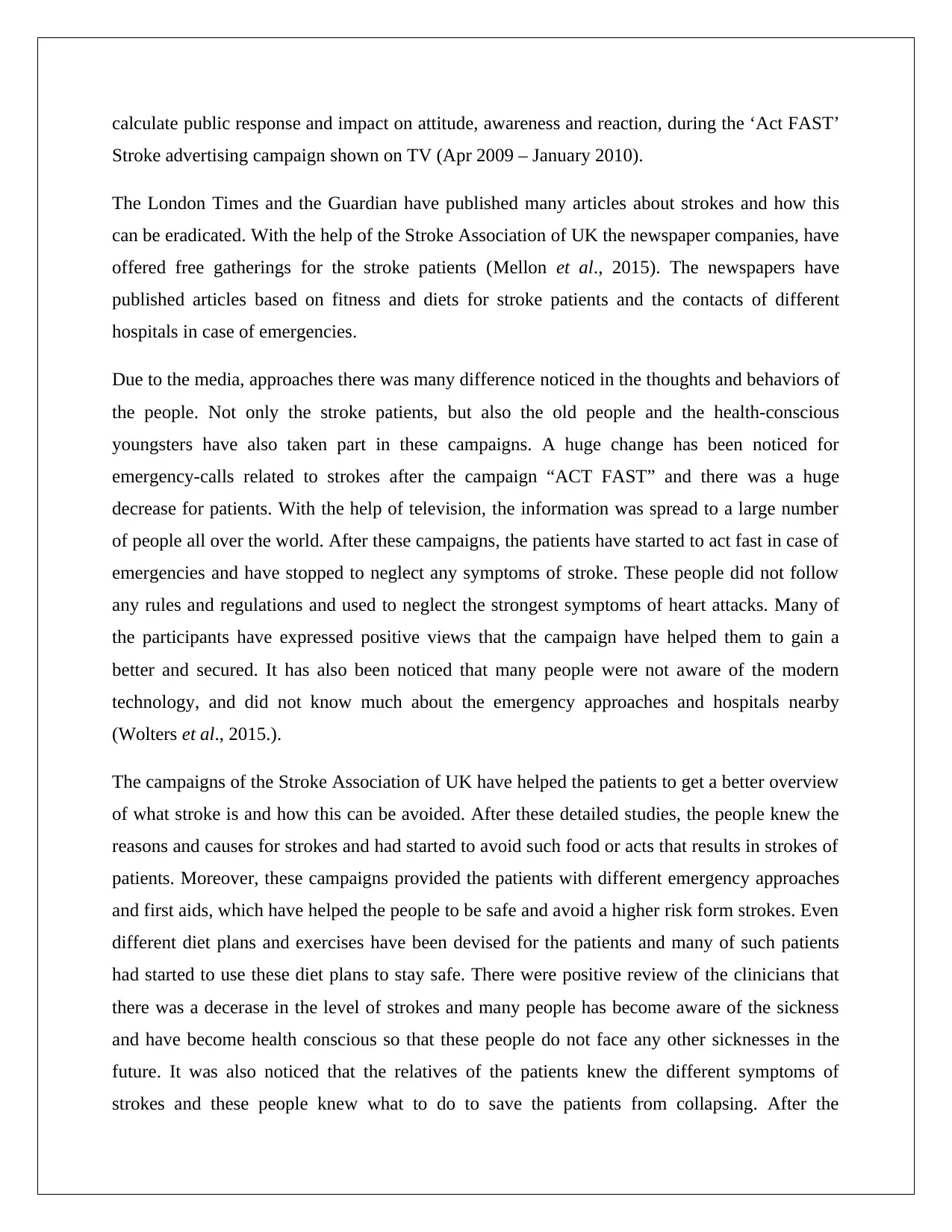
calculate public response and impact on attitude, awareness and reaction, during the ‘Act FAST’
Stroke advertising campaign shown on TV (Apr 2009 – January 2010).
The London Times and the Guardian have published many articles about strokes and how this
can be eradicated. With the help of the Stroke Association of UK the newspaper companies, have
offered free gatherings for the stroke patients (Mellon et al., 2015). The newspapers have
published articles based on fitness and diets for stroke patients and the contacts of different
hospitals in case of emergencies.
Due to the media, approaches there was many difference noticed in the thoughts and behaviors of
the people. Not only the stroke patients, but also the old people and the health-conscious
youngsters have also taken part in these campaigns. A huge change has been noticed for
emergency-calls related to strokes after the campaign “ACT FAST” and there was a huge
decrease for patients. With the help of television, the information was spread to a large number
of people all over the world. After these campaigns, the patients have started to act fast in case of
emergencies and have stopped to neglect any symptoms of stroke. These people did not follow
any rules and regulations and used to neglect the strongest symptoms of heart attacks. Many of
the participants have expressed positive views that the campaign have helped them to gain a
better and secured. It has also been noticed that many people were not aware of the modern
technology, and did not know much about the emergency approaches and hospitals nearby
(Wolters et al., 2015.).
The campaigns of the Stroke Association of UK have helped the patients to get a better overview
of what stroke is and how this can be avoided. After these detailed studies, the people knew the
reasons and causes for strokes and had started to avoid such food or acts that results in strokes of
patients. Moreover, these campaigns provided the patients with different emergency approaches
and first aids, which have helped the people to be safe and avoid a higher risk form strokes. Even
different diet plans and exercises have been devised for the patients and many of such patients
had started to use these diet plans to stay safe. There were positive review of the clinicians that
there was a decerase in the level of strokes and many people has become aware of the sickness
and have become health conscious so that these people do not face any other sicknesses in the
future. It was also noticed that the relatives of the patients knew the different symptoms of
strokes and these people knew what to do to save the patients from collapsing. After the
Stroke advertising campaign shown on TV (Apr 2009 – January 2010).
The London Times and the Guardian have published many articles about strokes and how this
can be eradicated. With the help of the Stroke Association of UK the newspaper companies, have
offered free gatherings for the stroke patients (Mellon et al., 2015). The newspapers have
published articles based on fitness and diets for stroke patients and the contacts of different
hospitals in case of emergencies.
Due to the media, approaches there was many difference noticed in the thoughts and behaviors of
the people. Not only the stroke patients, but also the old people and the health-conscious
youngsters have also taken part in these campaigns. A huge change has been noticed for
emergency-calls related to strokes after the campaign “ACT FAST” and there was a huge
decrease for patients. With the help of television, the information was spread to a large number
of people all over the world. After these campaigns, the patients have started to act fast in case of
emergencies and have stopped to neglect any symptoms of stroke. These people did not follow
any rules and regulations and used to neglect the strongest symptoms of heart attacks. Many of
the participants have expressed positive views that the campaign have helped them to gain a
better and secured. It has also been noticed that many people were not aware of the modern
technology, and did not know much about the emergency approaches and hospitals nearby
(Wolters et al., 2015.).
The campaigns of the Stroke Association of UK have helped the patients to get a better overview
of what stroke is and how this can be avoided. After these detailed studies, the people knew the
reasons and causes for strokes and had started to avoid such food or acts that results in strokes of
patients. Moreover, these campaigns provided the patients with different emergency approaches
and first aids, which have helped the people to be safe and avoid a higher risk form strokes. Even
different diet plans and exercises have been devised for the patients and many of such patients
had started to use these diet plans to stay safe. There were positive review of the clinicians that
there was a decerase in the level of strokes and many people has become aware of the sickness
and have become health conscious so that these people do not face any other sicknesses in the
future. It was also noticed that the relatives of the patients knew the different symptoms of
strokes and these people knew what to do to save the patients from collapsing. After the
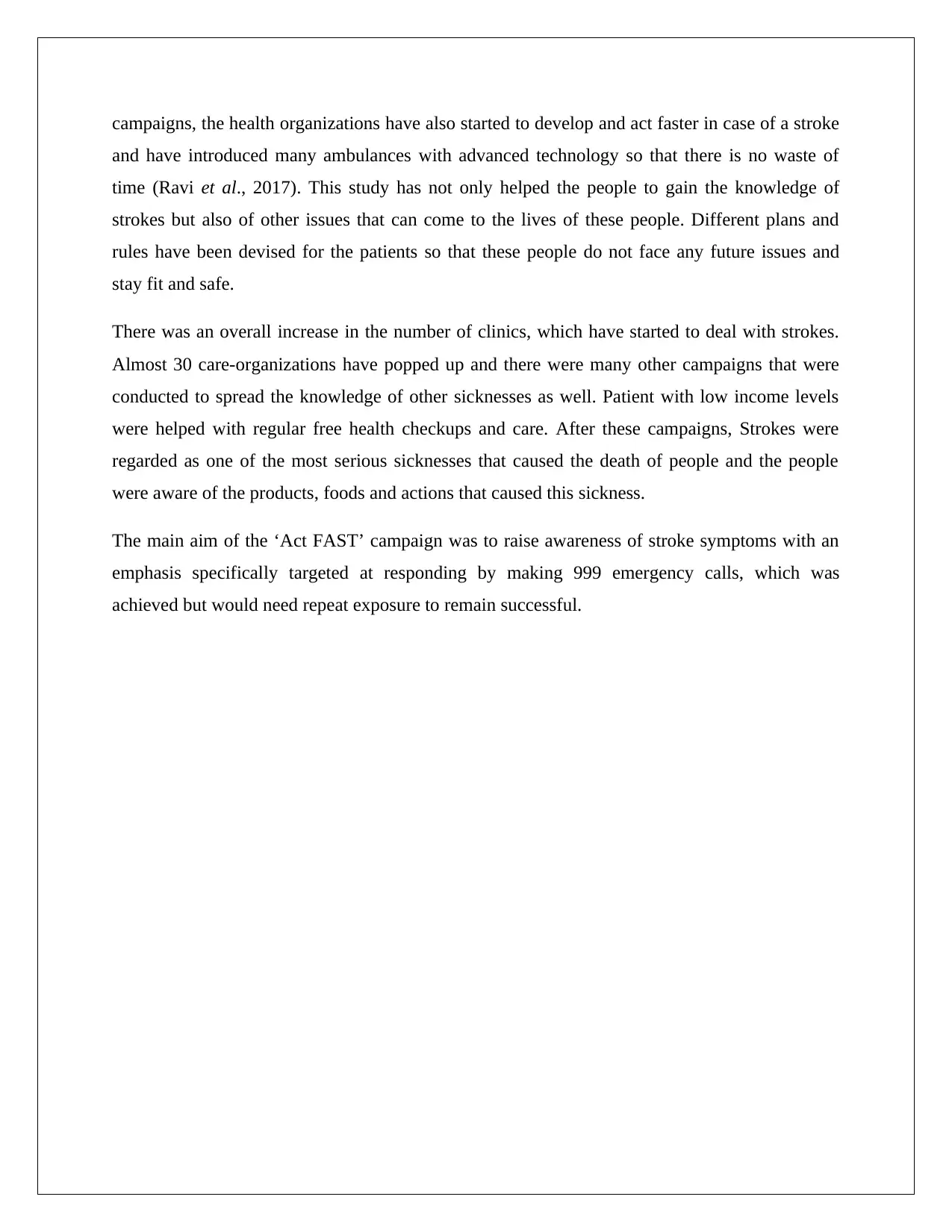
campaigns, the health organizations have also started to develop and act faster in case of a stroke
and have introduced many ambulances with advanced technology so that there is no waste of
time (Ravi et al., 2017). This study has not only helped the people to gain the knowledge of
strokes but also of other issues that can come to the lives of these people. Different plans and
rules have been devised for the patients so that these people do not face any future issues and
stay fit and safe.
There was an overall increase in the number of clinics, which have started to deal with strokes.
Almost 30 care-organizations have popped up and there were many other campaigns that were
conducted to spread the knowledge of other sicknesses as well. Patient with low income levels
were helped with regular free health checkups and care. After these campaigns, Strokes were
regarded as one of the most serious sicknesses that caused the death of people and the people
were aware of the products, foods and actions that caused this sickness.
The main aim of the ‘Act FAST’ campaign was to raise awareness of stroke symptoms with an
emphasis specifically targeted at responding by making 999 emergency calls, which was
achieved but would need repeat exposure to remain successful.
and have introduced many ambulances with advanced technology so that there is no waste of
time (Ravi et al., 2017). This study has not only helped the people to gain the knowledge of
strokes but also of other issues that can come to the lives of these people. Different plans and
rules have been devised for the patients so that these people do not face any future issues and
stay fit and safe.
There was an overall increase in the number of clinics, which have started to deal with strokes.
Almost 30 care-organizations have popped up and there were many other campaigns that were
conducted to spread the knowledge of other sicknesses as well. Patient with low income levels
were helped with regular free health checkups and care. After these campaigns, Strokes were
regarded as one of the most serious sicknesses that caused the death of people and the people
were aware of the products, foods and actions that caused this sickness.
The main aim of the ‘Act FAST’ campaign was to raise awareness of stroke symptoms with an
emphasis specifically targeted at responding by making 999 emergency calls, which was
achieved but would need repeat exposure to remain successful.
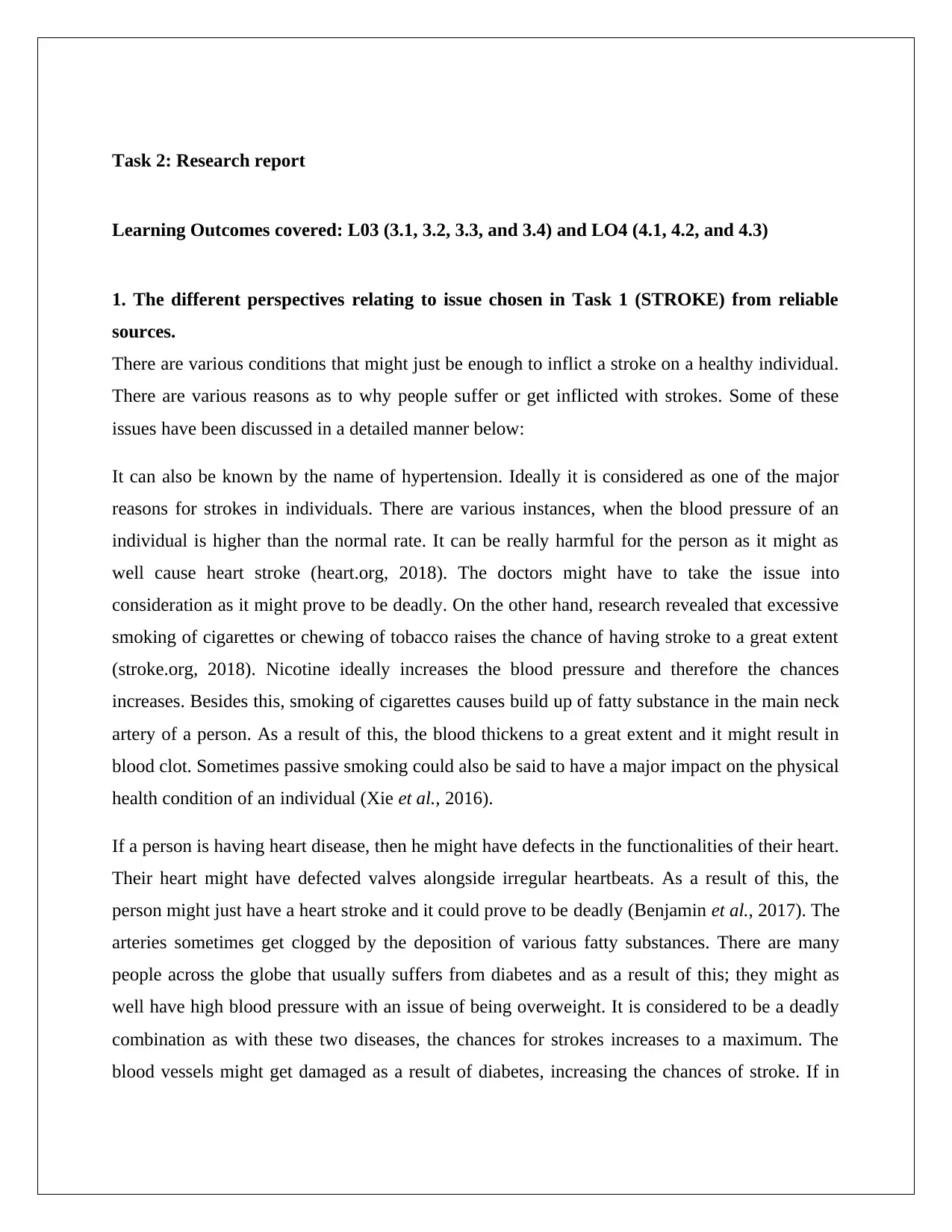
Task 2: Research report
Learning Outcomes covered: L03 (3.1, 3.2, 3.3, and 3.4) and LO4 (4.1, 4.2, and 4.3)
1. The different perspectives relating to issue chosen in Task 1 (STROKE) from reliable
sources.
There are various conditions that might just be enough to inflict a stroke on a healthy individual.
There are various reasons as to why people suffer or get inflicted with strokes. Some of these
issues have been discussed in a detailed manner below:
It can also be known by the name of hypertension. Ideally it is considered as one of the major
reasons for strokes in individuals. There are various instances, when the blood pressure of an
individual is higher than the normal rate. It can be really harmful for the person as it might as
well cause heart stroke (heart.org, 2018). The doctors might have to take the issue into
consideration as it might prove to be deadly. On the other hand, research revealed that excessive
smoking of cigarettes or chewing of tobacco raises the chance of having stroke to a great extent
(stroke.org, 2018). Nicotine ideally increases the blood pressure and therefore the chances
increases. Besides this, smoking of cigarettes causes build up of fatty substance in the main neck
artery of a person. As a result of this, the blood thickens to a great extent and it might result in
blood clot. Sometimes passive smoking could also be said to have a major impact on the physical
health condition of an individual (Xie et al., 2016).
If a person is having heart disease, then he might have defects in the functionalities of their heart.
Their heart might have defected valves alongside irregular heartbeats. As a result of this, the
person might just have a heart stroke and it could prove to be deadly (Benjamin et al., 2017). The
arteries sometimes get clogged by the deposition of various fatty substances. There are many
people across the globe that usually suffers from diabetes and as a result of this; they might as
well have high blood pressure with an issue of being overweight. It is considered to be a deadly
combination as with these two diseases, the chances for strokes increases to a maximum. The
blood vessels might get damaged as a result of diabetes, increasing the chances of stroke. If in
Learning Outcomes covered: L03 (3.1, 3.2, 3.3, and 3.4) and LO4 (4.1, 4.2, and 4.3)
1. The different perspectives relating to issue chosen in Task 1 (STROKE) from reliable
sources.
There are various conditions that might just be enough to inflict a stroke on a healthy individual.
There are various reasons as to why people suffer or get inflicted with strokes. Some of these
issues have been discussed in a detailed manner below:
It can also be known by the name of hypertension. Ideally it is considered as one of the major
reasons for strokes in individuals. There are various instances, when the blood pressure of an
individual is higher than the normal rate. It can be really harmful for the person as it might as
well cause heart stroke (heart.org, 2018). The doctors might have to take the issue into
consideration as it might prove to be deadly. On the other hand, research revealed that excessive
smoking of cigarettes or chewing of tobacco raises the chance of having stroke to a great extent
(stroke.org, 2018). Nicotine ideally increases the blood pressure and therefore the chances
increases. Besides this, smoking of cigarettes causes build up of fatty substance in the main neck
artery of a person. As a result of this, the blood thickens to a great extent and it might result in
blood clot. Sometimes passive smoking could also be said to have a major impact on the physical
health condition of an individual (Xie et al., 2016).
If a person is having heart disease, then he might have defects in the functionalities of their heart.
Their heart might have defected valves alongside irregular heartbeats. As a result of this, the
person might just have a heart stroke and it could prove to be deadly (Benjamin et al., 2017). The
arteries sometimes get clogged by the deposition of various fatty substances. There are many
people across the globe that usually suffers from diabetes and as a result of this; they might as
well have high blood pressure with an issue of being overweight. It is considered to be a deadly
combination as with these two diseases, the chances for strokes increases to a maximum. The
blood vessels might get damaged as a result of diabetes, increasing the chances of stroke. If in
Paraphrase This Document
Need a fresh take? Get an instant paraphrase of this document with our AI Paraphraser
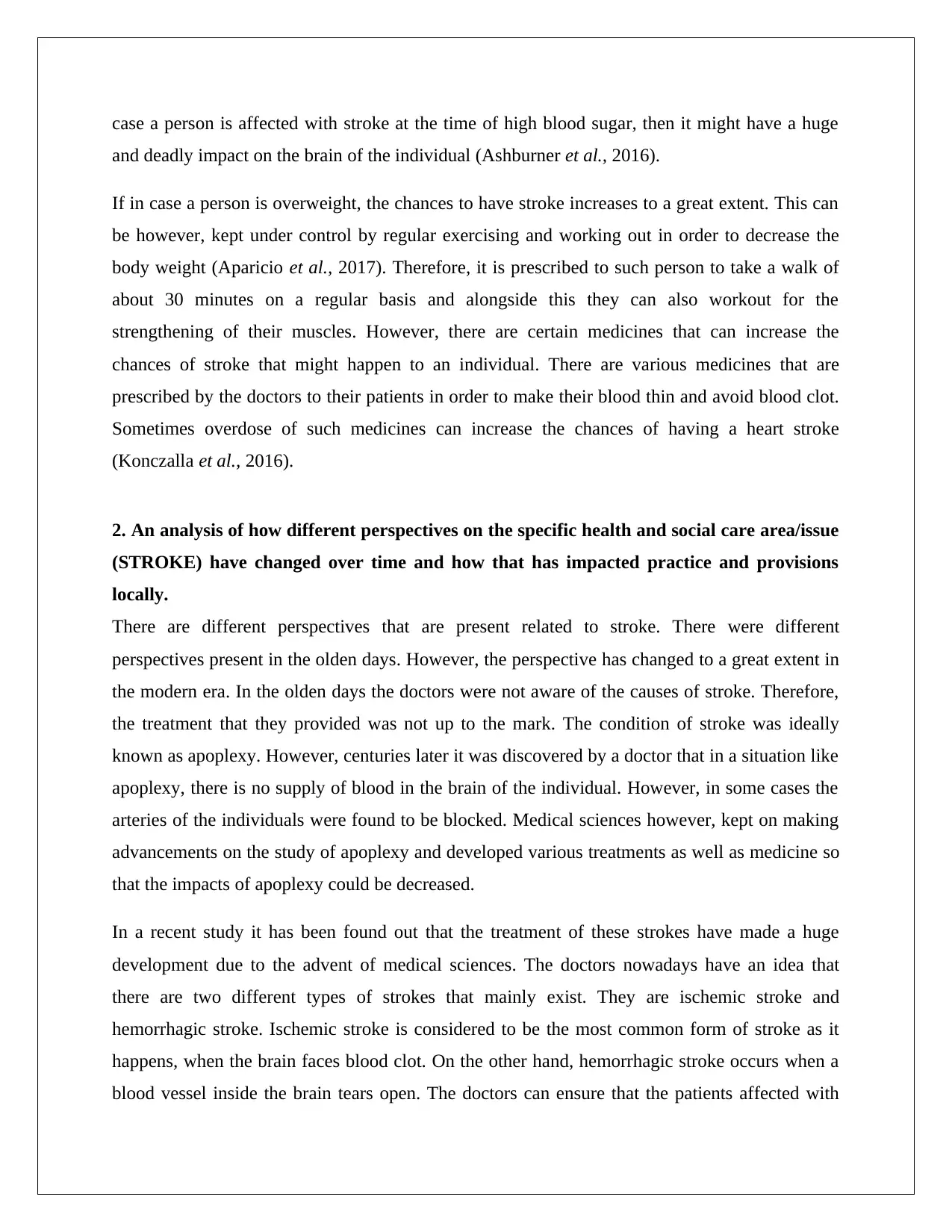
case a person is affected with stroke at the time of high blood sugar, then it might have a huge
and deadly impact on the brain of the individual (Ashburner et al., 2016).
If in case a person is overweight, the chances to have stroke increases to a great extent. This can
be however, kept under control by regular exercising and working out in order to decrease the
body weight (Aparicio et al., 2017). Therefore, it is prescribed to such person to take a walk of
about 30 minutes on a regular basis and alongside this they can also workout for the
strengthening of their muscles. However, there are certain medicines that can increase the
chances of stroke that might happen to an individual. There are various medicines that are
prescribed by the doctors to their patients in order to make their blood thin and avoid blood clot.
Sometimes overdose of such medicines can increase the chances of having a heart stroke
(Konczalla et al., 2016).
2. An analysis of how different perspectives on the specific health and social care area/issue
(STROKE) have changed over time and how that has impacted practice and provisions
locally.
There are different perspectives that are present related to stroke. There were different
perspectives present in the olden days. However, the perspective has changed to a great extent in
the modern era. In the olden days the doctors were not aware of the causes of stroke. Therefore,
the treatment that they provided was not up to the mark. The condition of stroke was ideally
known as apoplexy. However, centuries later it was discovered by a doctor that in a situation like
apoplexy, there is no supply of blood in the brain of the individual. However, in some cases the
arteries of the individuals were found to be blocked. Medical sciences however, kept on making
advancements on the study of apoplexy and developed various treatments as well as medicine so
that the impacts of apoplexy could be decreased.
In a recent study it has been found out that the treatment of these strokes have made a huge
development due to the advent of medical sciences. The doctors nowadays have an idea that
there are two different types of strokes that mainly exist. They are ischemic stroke and
hemorrhagic stroke. Ischemic stroke is considered to be the most common form of stroke as it
happens, when the brain faces blood clot. On the other hand, hemorrhagic stroke occurs when a
blood vessel inside the brain tears open. The doctors can ensure that the patients affected with
and deadly impact on the brain of the individual (Ashburner et al., 2016).
If in case a person is overweight, the chances to have stroke increases to a great extent. This can
be however, kept under control by regular exercising and working out in order to decrease the
body weight (Aparicio et al., 2017). Therefore, it is prescribed to such person to take a walk of
about 30 minutes on a regular basis and alongside this they can also workout for the
strengthening of their muscles. However, there are certain medicines that can increase the
chances of stroke that might happen to an individual. There are various medicines that are
prescribed by the doctors to their patients in order to make their blood thin and avoid blood clot.
Sometimes overdose of such medicines can increase the chances of having a heart stroke
(Konczalla et al., 2016).
2. An analysis of how different perspectives on the specific health and social care area/issue
(STROKE) have changed over time and how that has impacted practice and provisions
locally.
There are different perspectives that are present related to stroke. There were different
perspectives present in the olden days. However, the perspective has changed to a great extent in
the modern era. In the olden days the doctors were not aware of the causes of stroke. Therefore,
the treatment that they provided was not up to the mark. The condition of stroke was ideally
known as apoplexy. However, centuries later it was discovered by a doctor that in a situation like
apoplexy, there is no supply of blood in the brain of the individual. However, in some cases the
arteries of the individuals were found to be blocked. Medical sciences however, kept on making
advancements on the study of apoplexy and developed various treatments as well as medicine so
that the impacts of apoplexy could be decreased.
In a recent study it has been found out that the treatment of these strokes have made a huge
development due to the advent of medical sciences. The doctors nowadays have an idea that
there are two different types of strokes that mainly exist. They are ischemic stroke and
hemorrhagic stroke. Ischemic stroke is considered to be the most common form of stroke as it
happens, when the brain faces blood clot. On the other hand, hemorrhagic stroke occurs when a
blood vessel inside the brain tears open. The doctors can ensure that the patients affected with
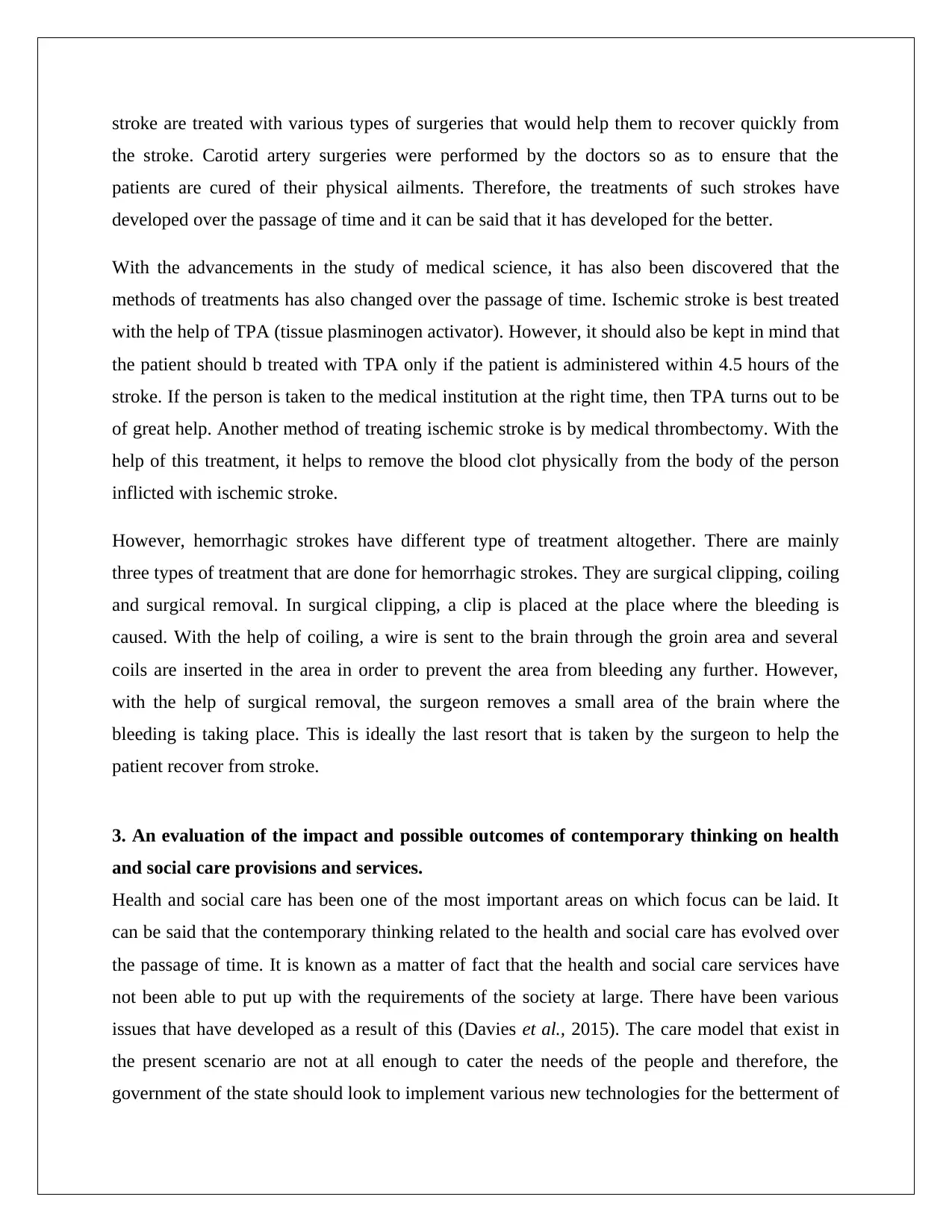
stroke are treated with various types of surgeries that would help them to recover quickly from
the stroke. Carotid artery surgeries were performed by the doctors so as to ensure that the
patients are cured of their physical ailments. Therefore, the treatments of such strokes have
developed over the passage of time and it can be said that it has developed for the better.
With the advancements in the study of medical science, it has also been discovered that the
methods of treatments has also changed over the passage of time. Ischemic stroke is best treated
with the help of TPA (tissue plasminogen activator). However, it should also be kept in mind that
the patient should b treated with TPA only if the patient is administered within 4.5 hours of the
stroke. If the person is taken to the medical institution at the right time, then TPA turns out to be
of great help. Another method of treating ischemic stroke is by medical thrombectomy. With the
help of this treatment, it helps to remove the blood clot physically from the body of the person
inflicted with ischemic stroke.
However, hemorrhagic strokes have different type of treatment altogether. There are mainly
three types of treatment that are done for hemorrhagic strokes. They are surgical clipping, coiling
and surgical removal. In surgical clipping, a clip is placed at the place where the bleeding is
caused. With the help of coiling, a wire is sent to the brain through the groin area and several
coils are inserted in the area in order to prevent the area from bleeding any further. However,
with the help of surgical removal, the surgeon removes a small area of the brain where the
bleeding is taking place. This is ideally the last resort that is taken by the surgeon to help the
patient recover from stroke.
3. An evaluation of the impact and possible outcomes of contemporary thinking on health
and social care provisions and services.
Health and social care has been one of the most important areas on which focus can be laid. It
can be said that the contemporary thinking related to the health and social care has evolved over
the passage of time. It is known as a matter of fact that the health and social care services have
not been able to put up with the requirements of the society at large. There have been various
issues that have developed as a result of this (Davies et al., 2015). The care model that exist in
the present scenario are not at all enough to cater the needs of the people and therefore, the
government of the state should look to implement various new technologies for the betterment of
the stroke. Carotid artery surgeries were performed by the doctors so as to ensure that the
patients are cured of their physical ailments. Therefore, the treatments of such strokes have
developed over the passage of time and it can be said that it has developed for the better.
With the advancements in the study of medical science, it has also been discovered that the
methods of treatments has also changed over the passage of time. Ischemic stroke is best treated
with the help of TPA (tissue plasminogen activator). However, it should also be kept in mind that
the patient should b treated with TPA only if the patient is administered within 4.5 hours of the
stroke. If the person is taken to the medical institution at the right time, then TPA turns out to be
of great help. Another method of treating ischemic stroke is by medical thrombectomy. With the
help of this treatment, it helps to remove the blood clot physically from the body of the person
inflicted with ischemic stroke.
However, hemorrhagic strokes have different type of treatment altogether. There are mainly
three types of treatment that are done for hemorrhagic strokes. They are surgical clipping, coiling
and surgical removal. In surgical clipping, a clip is placed at the place where the bleeding is
caused. With the help of coiling, a wire is sent to the brain through the groin area and several
coils are inserted in the area in order to prevent the area from bleeding any further. However,
with the help of surgical removal, the surgeon removes a small area of the brain where the
bleeding is taking place. This is ideally the last resort that is taken by the surgeon to help the
patient recover from stroke.
3. An evaluation of the impact and possible outcomes of contemporary thinking on health
and social care provisions and services.
Health and social care has been one of the most important areas on which focus can be laid. It
can be said that the contemporary thinking related to the health and social care has evolved over
the passage of time. It is known as a matter of fact that the health and social care services have
not been able to put up with the requirements of the society at large. There have been various
issues that have developed as a result of this (Davies et al., 2015). The care model that exist in
the present scenario are not at all enough to cater the needs of the people and therefore, the
government of the state should look to implement various new technologies for the betterment of
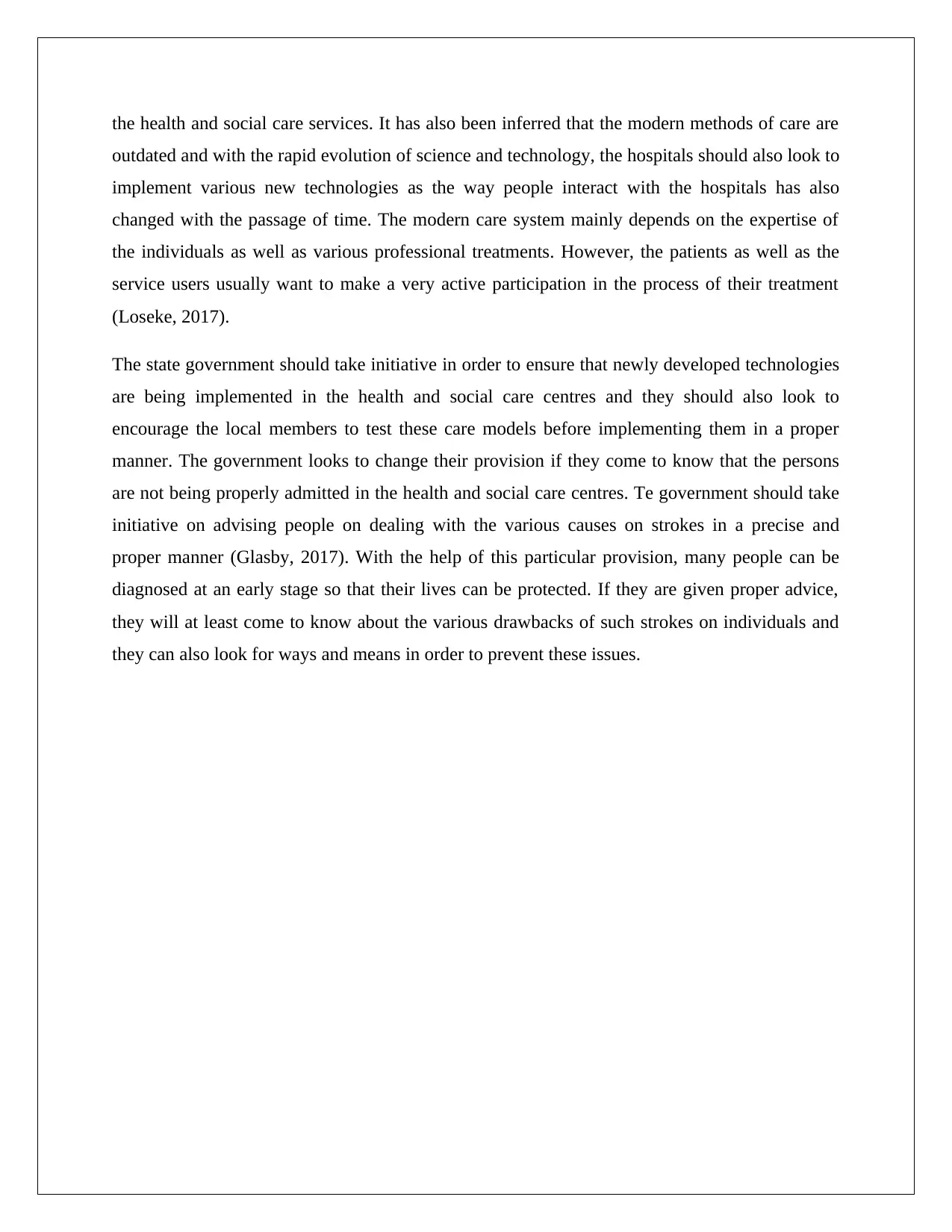
the health and social care services. It has also been inferred that the modern methods of care are
outdated and with the rapid evolution of science and technology, the hospitals should also look to
implement various new technologies as the way people interact with the hospitals has also
changed with the passage of time. The modern care system mainly depends on the expertise of
the individuals as well as various professional treatments. However, the patients as well as the
service users usually want to make a very active participation in the process of their treatment
(Loseke, 2017).
The state government should take initiative in order to ensure that newly developed technologies
are being implemented in the health and social care centres and they should also look to
encourage the local members to test these care models before implementing them in a proper
manner. The government looks to change their provision if they come to know that the persons
are not being properly admitted in the health and social care centres. Te government should take
initiative on advising people on dealing with the various causes on strokes in a precise and
proper manner (Glasby, 2017). With the help of this particular provision, many people can be
diagnosed at an early stage so that their lives can be protected. If they are given proper advice,
they will at least come to know about the various drawbacks of such strokes on individuals and
they can also look for ways and means in order to prevent these issues.
outdated and with the rapid evolution of science and technology, the hospitals should also look to
implement various new technologies as the way people interact with the hospitals has also
changed with the passage of time. The modern care system mainly depends on the expertise of
the individuals as well as various professional treatments. However, the patients as well as the
service users usually want to make a very active participation in the process of their treatment
(Loseke, 2017).
The state government should take initiative in order to ensure that newly developed technologies
are being implemented in the health and social care centres and they should also look to
encourage the local members to test these care models before implementing them in a proper
manner. The government looks to change their provision if they come to know that the persons
are not being properly admitted in the health and social care centres. Te government should take
initiative on advising people on dealing with the various causes on strokes in a precise and
proper manner (Glasby, 2017). With the help of this particular provision, many people can be
diagnosed at an early stage so that their lives can be protected. If they are given proper advice,
they will at least come to know about the various drawbacks of such strokes on individuals and
they can also look for ways and means in order to prevent these issues.
Secure Best Marks with AI Grader
Need help grading? Try our AI Grader for instant feedback on your assignments.
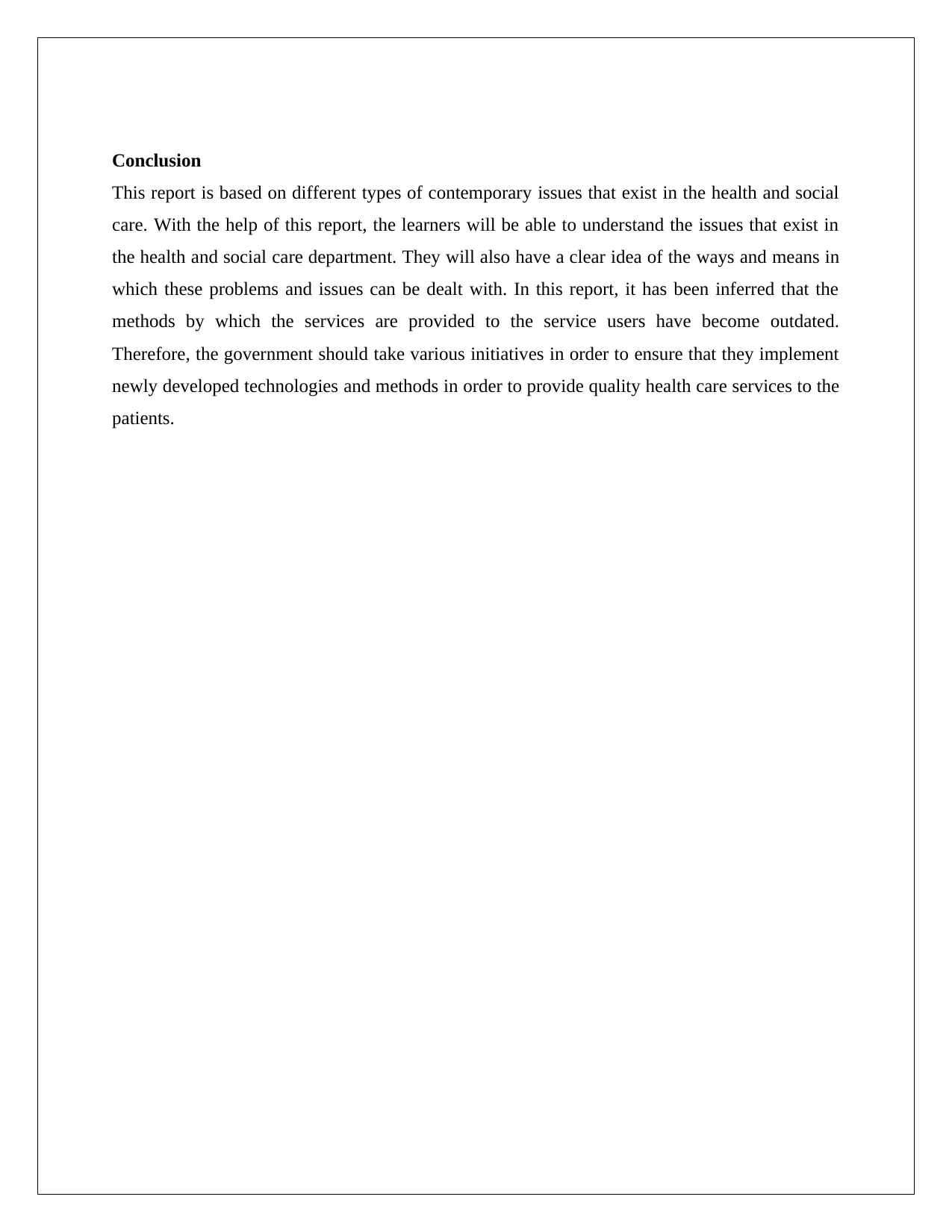
Conclusion
This report is based on different types of contemporary issues that exist in the health and social
care. With the help of this report, the learners will be able to understand the issues that exist in
the health and social care department. They will also have a clear idea of the ways and means in
which these problems and issues can be dealt with. In this report, it has been inferred that the
methods by which the services are provided to the service users have become outdated.
Therefore, the government should take various initiatives in order to ensure that they implement
newly developed technologies and methods in order to provide quality health care services to the
patients.
This report is based on different types of contemporary issues that exist in the health and social
care. With the help of this report, the learners will be able to understand the issues that exist in
the health and social care department. They will also have a clear idea of the ways and means in
which these problems and issues can be dealt with. In this report, it has been inferred that the
methods by which the services are provided to the service users have become outdated.
Therefore, the government should take various initiatives in order to ensure that they implement
newly developed technologies and methods in order to provide quality health care services to the
patients.
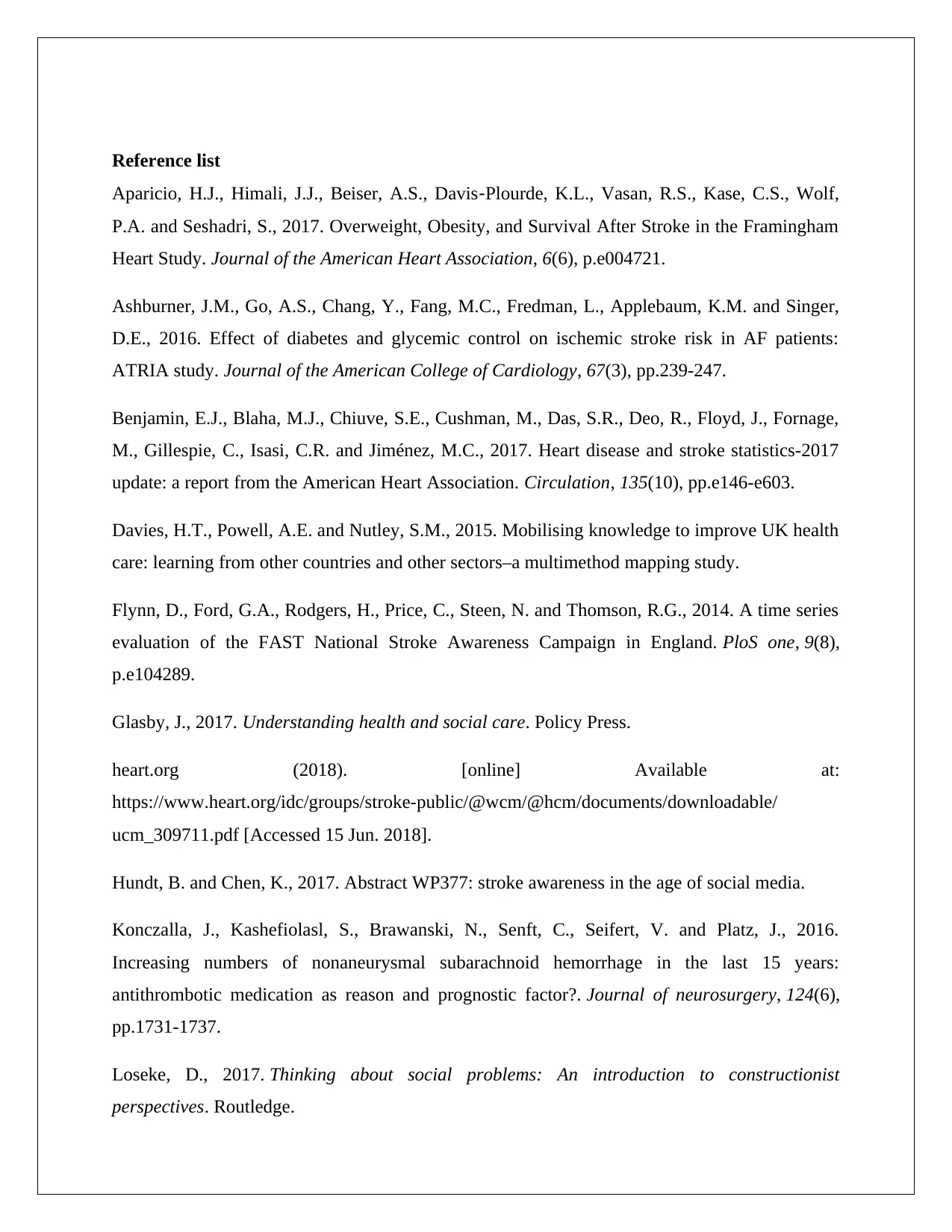
Reference list
Aparicio, H.J., Himali, J.J., Beiser, A.S., Davis‐Plourde, K.L., Vasan, R.S., Kase, C.S., Wolf,
P.A. and Seshadri, S., 2017. Overweight, Obesity, and Survival After Stroke in the Framingham
Heart Study. Journal of the American Heart Association, 6(6), p.e004721.
Ashburner, J.M., Go, A.S., Chang, Y., Fang, M.C., Fredman, L., Applebaum, K.M. and Singer,
D.E., 2016. Effect of diabetes and glycemic control on ischemic stroke risk in AF patients:
ATRIA study. Journal of the American College of Cardiology, 67(3), pp.239-247.
Benjamin, E.J., Blaha, M.J., Chiuve, S.E., Cushman, M., Das, S.R., Deo, R., Floyd, J., Fornage,
M., Gillespie, C., Isasi, C.R. and Jiménez, M.C., 2017. Heart disease and stroke statistics-2017
update: a report from the American Heart Association. Circulation, 135(10), pp.e146-e603.
Davies, H.T., Powell, A.E. and Nutley, S.M., 2015. Mobilising knowledge to improve UK health
care: learning from other countries and other sectors–a multimethod mapping study.
Flynn, D., Ford, G.A., Rodgers, H., Price, C., Steen, N. and Thomson, R.G., 2014. A time series
evaluation of the FAST National Stroke Awareness Campaign in England. PloS one, 9(8),
p.e104289.
Glasby, J., 2017. Understanding health and social care. Policy Press.
heart.org (2018). [online] Available at:
https://www.heart.org/idc/groups/stroke-public/@wcm/@hcm/documents/downloadable/
ucm_309711.pdf [Accessed 15 Jun. 2018].
Hundt, B. and Chen, K., 2017. Abstract WP377: stroke awareness in the age of social media.
Konczalla, J., Kashefiolasl, S., Brawanski, N., Senft, C., Seifert, V. and Platz, J., 2016.
Increasing numbers of nonaneurysmal subarachnoid hemorrhage in the last 15 years:
antithrombotic medication as reason and prognostic factor?. Journal of neurosurgery, 124(6),
pp.1731-1737.
Loseke, D., 2017. Thinking about social problems: An introduction to constructionist
perspectives. Routledge.
Aparicio, H.J., Himali, J.J., Beiser, A.S., Davis‐Plourde, K.L., Vasan, R.S., Kase, C.S., Wolf,
P.A. and Seshadri, S., 2017. Overweight, Obesity, and Survival After Stroke in the Framingham
Heart Study. Journal of the American Heart Association, 6(6), p.e004721.
Ashburner, J.M., Go, A.S., Chang, Y., Fang, M.C., Fredman, L., Applebaum, K.M. and Singer,
D.E., 2016. Effect of diabetes and glycemic control on ischemic stroke risk in AF patients:
ATRIA study. Journal of the American College of Cardiology, 67(3), pp.239-247.
Benjamin, E.J., Blaha, M.J., Chiuve, S.E., Cushman, M., Das, S.R., Deo, R., Floyd, J., Fornage,
M., Gillespie, C., Isasi, C.R. and Jiménez, M.C., 2017. Heart disease and stroke statistics-2017
update: a report from the American Heart Association. Circulation, 135(10), pp.e146-e603.
Davies, H.T., Powell, A.E. and Nutley, S.M., 2015. Mobilising knowledge to improve UK health
care: learning from other countries and other sectors–a multimethod mapping study.
Flynn, D., Ford, G.A., Rodgers, H., Price, C., Steen, N. and Thomson, R.G., 2014. A time series
evaluation of the FAST National Stroke Awareness Campaign in England. PloS one, 9(8),
p.e104289.
Glasby, J., 2017. Understanding health and social care. Policy Press.
heart.org (2018). [online] Available at:
https://www.heart.org/idc/groups/stroke-public/@wcm/@hcm/documents/downloadable/
ucm_309711.pdf [Accessed 15 Jun. 2018].
Hundt, B. and Chen, K., 2017. Abstract WP377: stroke awareness in the age of social media.
Konczalla, J., Kashefiolasl, S., Brawanski, N., Senft, C., Seifert, V. and Platz, J., 2016.
Increasing numbers of nonaneurysmal subarachnoid hemorrhage in the last 15 years:
antithrombotic medication as reason and prognostic factor?. Journal of neurosurgery, 124(6),
pp.1731-1737.
Loseke, D., 2017. Thinking about social problems: An introduction to constructionist
perspectives. Routledge.
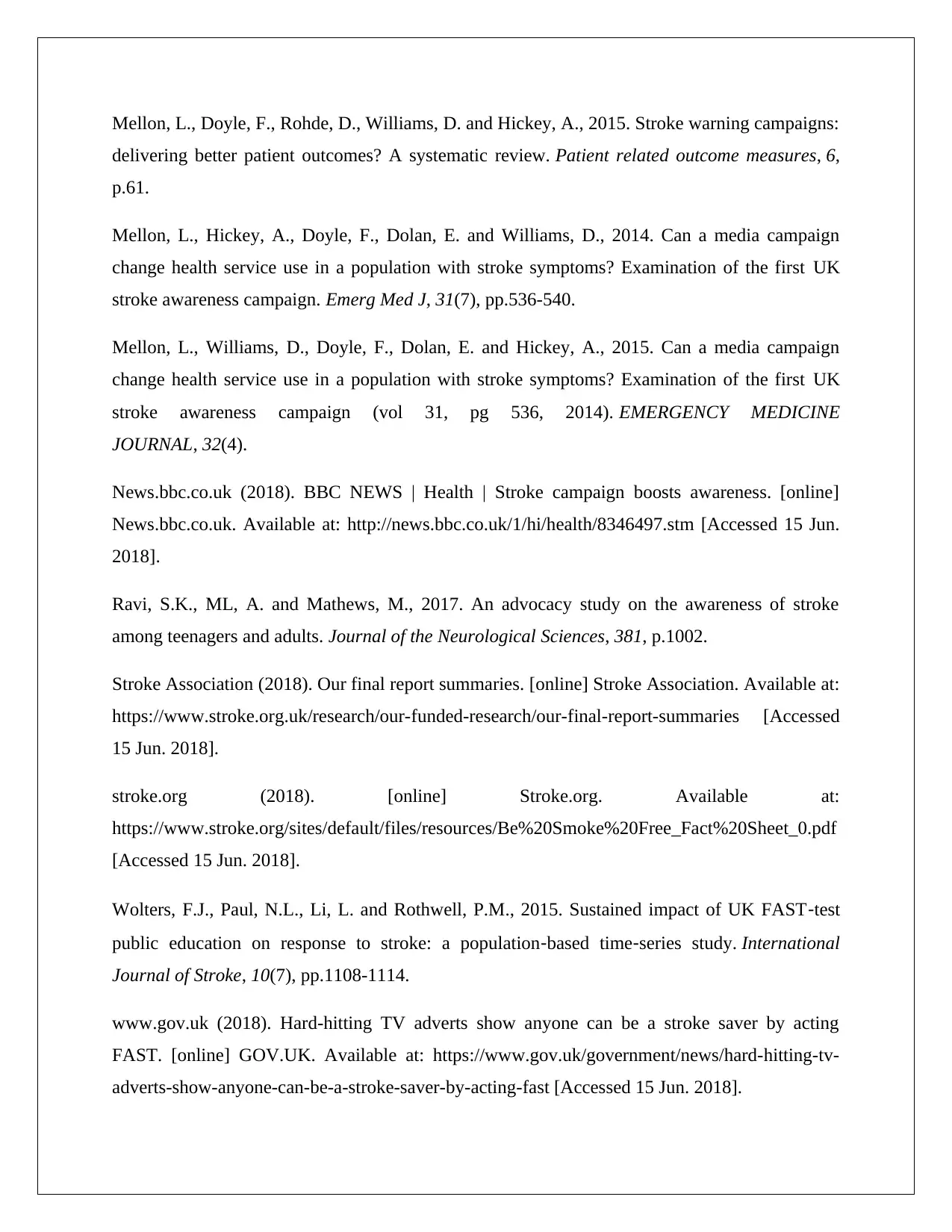
Mellon, L., Doyle, F., Rohde, D., Williams, D. and Hickey, A., 2015. Stroke warning campaigns:
delivering better patient outcomes? A systematic review. Patient related outcome measures, 6,
p.61.
Mellon, L., Hickey, A., Doyle, F., Dolan, E. and Williams, D., 2014. Can a media campaign
change health service use in a population with stroke symptoms? Examination of the first UK
stroke awareness campaign. Emerg Med J, 31(7), pp.536-540.
Mellon, L., Williams, D., Doyle, F., Dolan, E. and Hickey, A., 2015. Can a media campaign
change health service use in a population with stroke symptoms? Examination of the first UK
stroke awareness campaign (vol 31, pg 536, 2014). EMERGENCY MEDICINE
JOURNAL, 32(4).
News.bbc.co.uk (2018). BBC NEWS | Health | Stroke campaign boosts awareness. [online]
News.bbc.co.uk. Available at: http://news.bbc.co.uk/1/hi/health/8346497.stm [Accessed 15 Jun.
2018].
Ravi, S.K., ML, A. and Mathews, M., 2017. An advocacy study on the awareness of stroke
among teenagers and adults. Journal of the Neurological Sciences, 381, p.1002.
Stroke Association (2018). Our final report summaries. [online] Stroke Association. Available at:
https://www.stroke.org.uk/research/our-funded-research/our-final-report-summaries [Accessed
15 Jun. 2018].
stroke.org (2018). [online] Stroke.org. Available at:
https://www.stroke.org/sites/default/files/resources/Be%20Smoke%20Free_Fact%20Sheet_0.pdf
[Accessed 15 Jun. 2018].
Wolters, F.J., Paul, N.L., Li, L. and Rothwell, P.M., 2015. Sustained impact of UK FAST‐test
public education on response to stroke: a population‐based time‐series study. International
Journal of Stroke, 10(7), pp.1108-1114.
www.gov.uk (2018). Hard-hitting TV adverts show anyone can be a stroke saver by acting
FAST. [online] GOV.UK. Available at: https://www.gov.uk/government/news/hard-hitting-tv-
adverts-show-anyone-can-be-a-stroke-saver-by-acting-fast [Accessed 15 Jun. 2018].
delivering better patient outcomes? A systematic review. Patient related outcome measures, 6,
p.61.
Mellon, L., Hickey, A., Doyle, F., Dolan, E. and Williams, D., 2014. Can a media campaign
change health service use in a population with stroke symptoms? Examination of the first UK
stroke awareness campaign. Emerg Med J, 31(7), pp.536-540.
Mellon, L., Williams, D., Doyle, F., Dolan, E. and Hickey, A., 2015. Can a media campaign
change health service use in a population with stroke symptoms? Examination of the first UK
stroke awareness campaign (vol 31, pg 536, 2014). EMERGENCY MEDICINE
JOURNAL, 32(4).
News.bbc.co.uk (2018). BBC NEWS | Health | Stroke campaign boosts awareness. [online]
News.bbc.co.uk. Available at: http://news.bbc.co.uk/1/hi/health/8346497.stm [Accessed 15 Jun.
2018].
Ravi, S.K., ML, A. and Mathews, M., 2017. An advocacy study on the awareness of stroke
among teenagers and adults. Journal of the Neurological Sciences, 381, p.1002.
Stroke Association (2018). Our final report summaries. [online] Stroke Association. Available at:
https://www.stroke.org.uk/research/our-funded-research/our-final-report-summaries [Accessed
15 Jun. 2018].
stroke.org (2018). [online] Stroke.org. Available at:
https://www.stroke.org/sites/default/files/resources/Be%20Smoke%20Free_Fact%20Sheet_0.pdf
[Accessed 15 Jun. 2018].
Wolters, F.J., Paul, N.L., Li, L. and Rothwell, P.M., 2015. Sustained impact of UK FAST‐test
public education on response to stroke: a population‐based time‐series study. International
Journal of Stroke, 10(7), pp.1108-1114.
www.gov.uk (2018). Hard-hitting TV adverts show anyone can be a stroke saver by acting
FAST. [online] GOV.UK. Available at: https://www.gov.uk/government/news/hard-hitting-tv-
adverts-show-anyone-can-be-a-stroke-saver-by-acting-fast [Accessed 15 Jun. 2018].
Paraphrase This Document
Need a fresh take? Get an instant paraphrase of this document with our AI Paraphraser
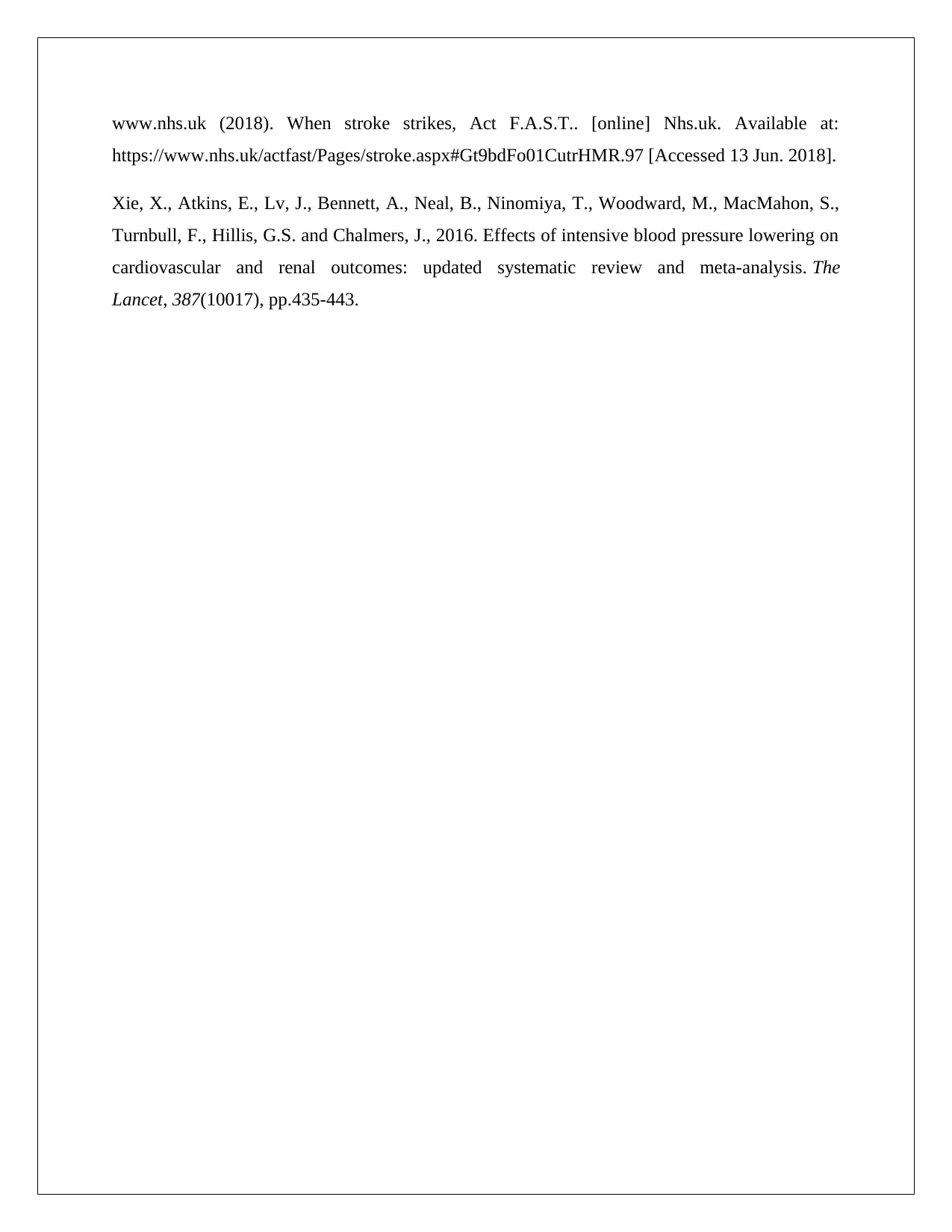
www.nhs.uk (2018). When stroke strikes, Act F.A.S.T.. [online] Nhs.uk. Available at:
https://www.nhs.uk/actfast/Pages/stroke.aspx#Gt9bdFo01CutrHMR.97 [Accessed 13 Jun. 2018].
Xie, X., Atkins, E., Lv, J., Bennett, A., Neal, B., Ninomiya, T., Woodward, M., MacMahon, S.,
Turnbull, F., Hillis, G.S. and Chalmers, J., 2016. Effects of intensive blood pressure lowering on
cardiovascular and renal outcomes: updated systematic review and meta-analysis. The
Lancet, 387(10017), pp.435-443.
https://www.nhs.uk/actfast/Pages/stroke.aspx#Gt9bdFo01CutrHMR.97 [Accessed 13 Jun. 2018].
Xie, X., Atkins, E., Lv, J., Bennett, A., Neal, B., Ninomiya, T., Woodward, M., MacMahon, S.,
Turnbull, F., Hillis, G.S. and Chalmers, J., 2016. Effects of intensive blood pressure lowering on
cardiovascular and renal outcomes: updated systematic review and meta-analysis. The
Lancet, 387(10017), pp.435-443.
1 out of 20
Related Documents
Your All-in-One AI-Powered Toolkit for Academic Success.
+13062052269
info@desklib.com
Available 24*7 on WhatsApp / Email
![[object Object]](/_next/static/media/star-bottom.7253800d.svg)
Unlock your academic potential
© 2024 | Zucol Services PVT LTD | All rights reserved.





